Cobra Electronics MRHH400 Marine Transceiver - Transmitter User Manual HH400 3b
Cobra Electronics Corporation Marine Transceiver - Transmitter HH400 3b
users manual
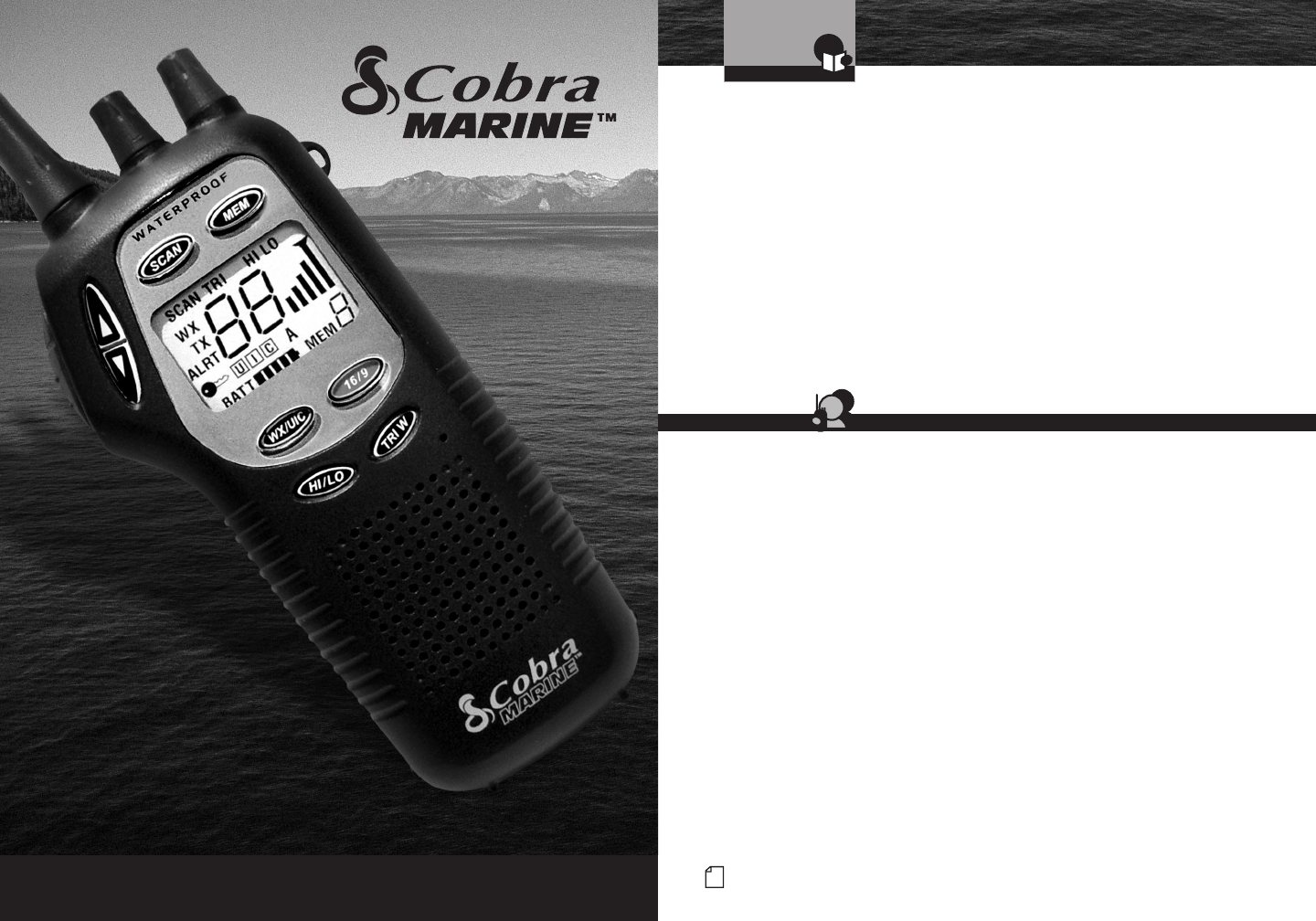
A1 English
Our Thanks to You and
Customer Assistance
Introduction
VHF MARINE RADIO
MR HH400
Printed in China
Part No. 480-084-P
Owner’s Manual
Nothing Comes Close To A Cobra®English
Thank you for purchasing a CobraMarine™VHF radio.
Properly used, this Cobra®product will give you
many years of reliable service.
How Your CobraMarine™VHF Radio Works
This radio is a battery powered portable transceiver for use afloat. It gives you
two-way vessel-to-vessel and vessel-to-shore station communications, primarily
for safety and secondarily for navigation and operational purposes. With it, you can
call for help, get information from other boaters, talk to lock or bridge tenders,
and make radiotelephone calls to anywhere in the world through a marine operator.
Besides two-way communications, the radio can provide quick access to receive
all ten NOAA (National Oceanographic and Atmospheric Administration) weather
channels and alert you to weather emergencies with a tone on a weather channel
you can select for your area.
Customer Assistance
Should you encounter any problems with this product, or not understand
its many features, please refer to this owner’s manual. If you require further
assistance after reading this manual, Cobra®Electronics offers the following
customer assistance services:
For Assistance In the U.S.A.
Automated Help Desk English only.
24 hours a day, 7 days a week 773-889-3087 (phone).
Customer Assistance Operators English and Spanish.
8:00 a.m. to 6:00 p.m. CT Mon. through Fri. (except holidays) 773-889-3087 (phone).
Questions English and Spanish.
Faxes can be received at 773-622-2269 (fax).
Technical Assistance English only.
www.cobra.com (on-line: Frequently Asked Questions).
English and Spanish. productinfo@cobra.com (e-mail).
For Assistance Outside the U.S.A.
Contact Your Local Dealer
Customer Assistance
©2003 Cobra®Electronics Corporation
6500 West Cortland Street
Chicago, Illinois 60707 USA
www.cobra.com
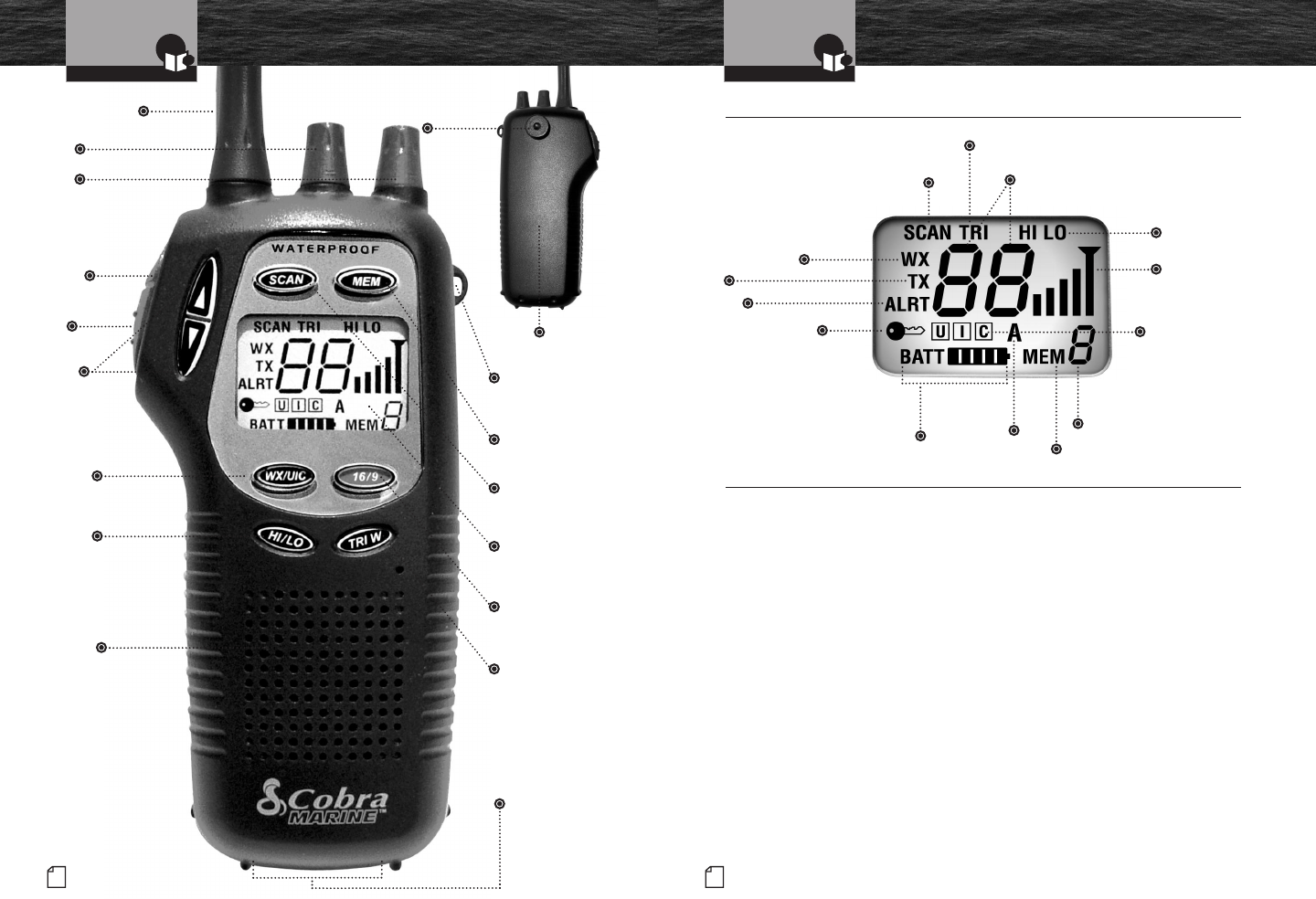
A3 English
Indicators and
Product Features
Introduction
A2 English
Controls and Indicators
Introduction
Dual Power
Selectable to one (1) or five (5) watts
output power for near or distant calling.
USA/International/Canada Channels
Allows operation on any of the three (3)
different channel maps established for
these areas.
10 NOAA Weather Channels
Instant access to all of the National
Weather Channels, 24 hours a day.
Emergency Weather Alert
Can alert you with an audible tone
and visual alarm if threatening weather
is nearby.
Waterproof
Submersible to one (1) meter of water
for 30 minutes — meets Standard JIS7.
Scan
Lets you scan through all channels or
up to ten (10) selected memory locations
to find conversations in progress.
Button Lock
Prevents accidental changes to your
settings when you set this feature.
Instant Channel 16/9
Instant access to priority Channel 16
and calling Channel 9.
Tri-Watch
Lets you monitor three (3) channels
at once — Channel 16 and two (2) user
programmable channels.
Six AA Rechargeable NiMH Batteries Included
Provides extended operating time compared
to alkaline batteries with no memory effect.
Drop-in 120v/12v Desk Charger Included
Lets you charge the batteries right in the radio
— at home, in your car, or in your boat.
Product Features •
Weather
Channel
Icon
Battery
Power Icon
Memory Icon
Simplex
Operation
Icon
Memory
Location
Number
Channel
Numbers
Tri Watch
Icon
Scan
Icon
Button
Lock
Icon
U-I-C Active
Channel Map
Icons
Tri-Watch
Button
Instant
Channel
16/9 Button
Scan
Button
Backlit
LCD Screen
Memory
Button
Wrist
Strap
Connector
Received
Signal
Strength
Icons
High/Low
Power Icons
Weather
Alert Icon
Transmit
Icon
Weather/
UIC Button
High/Low
Power Button
Speaker/
Microphone
Channel
Up/Down
Buttons
Talk
Button
Antenna Belt Clip
Engagement
Knob
Battery
Compartment
Squelch
Knob
On-Off Power/
Volume Knob
Backlight/
Key Lock
Button
Backlit LCD (Liquid Crystal Display) Screen •
Charging
Contacts
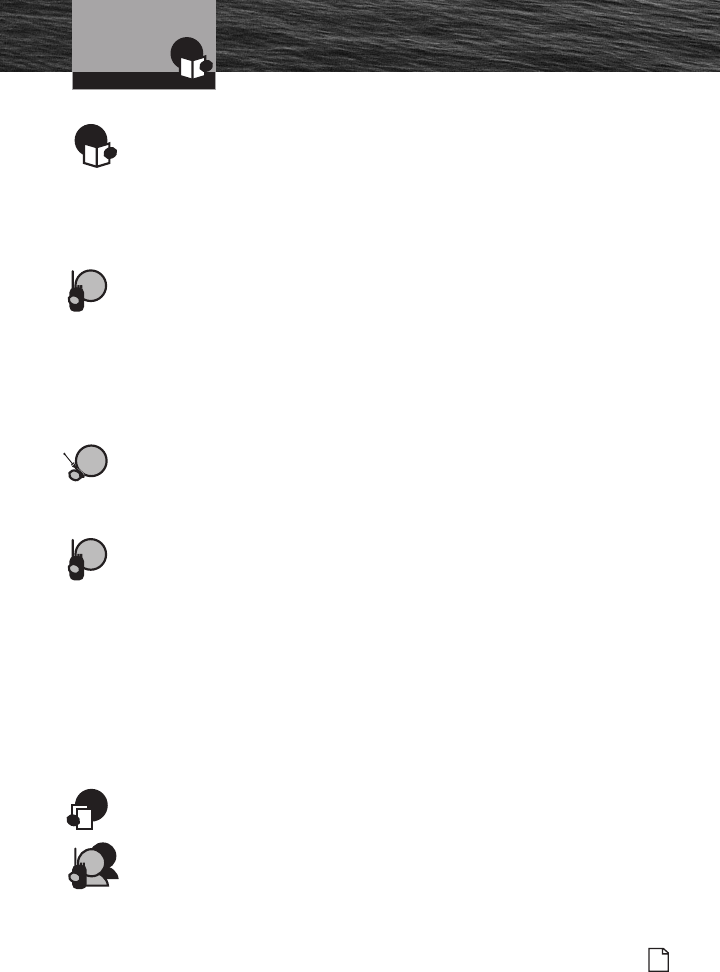
Introduction
1
Nothing comes close to a Cobra®
Table of Contents
Introduction
Our Thanks to You . . . . . . . . . . . . . . . . . . . . . . . . . . . . . . . . . . . . . . . A1
Customer Assistance . . . . . . . . . . . . . . . . . . . . . . . . . . . . . . . . . . . . . A1
Controls and Indicators . . . . . . . . . . . . . . . . . . . . . . . . . . . . . . . . . . . A2
Indicators and Product Features . . . . . . . . . . . . . . . . . . . . . . . . . . . . . A3
Important Safety Information . . . . . . . . . . . . . . . . . . . . . . . . . . . . . . . . 2
Recommendations for Marine Communication . . . . . . . . . . . . . . . . . . 5
VHF Marine Radio Protocols
FCC Information . . . . . . . . . . . . . . . . . . . . . . . . . . . . . . . . . . . . . . . . . . 5
VHF Marine Radio Procedures . . . . . . . . . . . . . . . . . . . . . . . . . . . . . . . 7
Voice Calling . . . . . . . . . . . . . . . . . . . . . . . . . . . . . . . . . . . . . . . . . . . . . 8
Radiotelephone Calls . . . . . . . . . . . . . . . . . . . . . . . . . . . . . . . . . . . . . . 9
Emergency Messages and Distress Procedure . . . . . . . . . . . . . . . . . . 10
VHF Marine Channel Assignments . . . . . . . . . . . . . . . . . . . . . . . . . . . 14
NOAA Weather Channels . . . . . . . . . . . . . . . . . . . . . . . . . . . . . . . . . . 24
Installation
Included in This Package . . . . . . . . . . . . . . . . . . . . . . . . . . . . . . . . . . 25
Antenna, Wrist Strap, and Belt Clip . . . . . . . . . . . . . . . . . . . . . . . . . . 26
Batteries and Charger . . . . . . . . . . . . . . . . . . . . . . . . . . . . . . . . . . . . . 27
Operating Your Radio
Getting Started . . . . . . . . . . . . . . . . . . . . . . . . . . . . . . . . . . . . . . . . . . 30
Standby/Receive and Transmit . . . . . . . . . . . . . . . . . . . . . . . . . . . . . . 34
Weather Radio and Alerts . . . . . . . . . . . . . . . . . . . . . . . . . . . . . . . . . . 36
Advanced Operation . . . . . . . . . . . . . . . . . . . . . . . . . . . . . . . . . . . . . . 37
Channel 16/9 . . . . . . . . . . . . . . . . . . . . . . . . . . . . . . . . . . . . . . . . . 37
Tri-Watch . . . . . . . . . . . . . . . . . . . . . . . . . . . . . . . . . . . . . . . . . . . . 38
Memory Locations . . . . . . . . . . . . . . . . . . . . . . . . . . . . . . . . . . . . . 40
Channel Scan . . . . . . . . . . . . . . . . . . . . . . . . . . . . . . . . . . . . . . . . . 41
Memory Location Scan . . . . . . . . . . . . . . . . . . . . . . . . . . . . . . . . . 42
Maintenance and Troubleshooting . . . . . . . . . . . . . . . . . . . . . . . . . . . 44
Specifications . . . . . . . . . . . . . . . . . . . . . . . . . . . . . . . . . . . . . . . . . . . 45
Warranty
Warranty . . . . . . . . . . . . . . . . . . . . . . . . . . . . . . . . . . . . . . . . . . . . . . . 46
Customer Service
Product Service . . . . . . . . . . . . . . . . . . . . . . . . . . . . . . . . . . . . . . . . . 47
Optional Accessories and Order Form . . . . . . . . . . . . . . . . . . . . . . . . 48
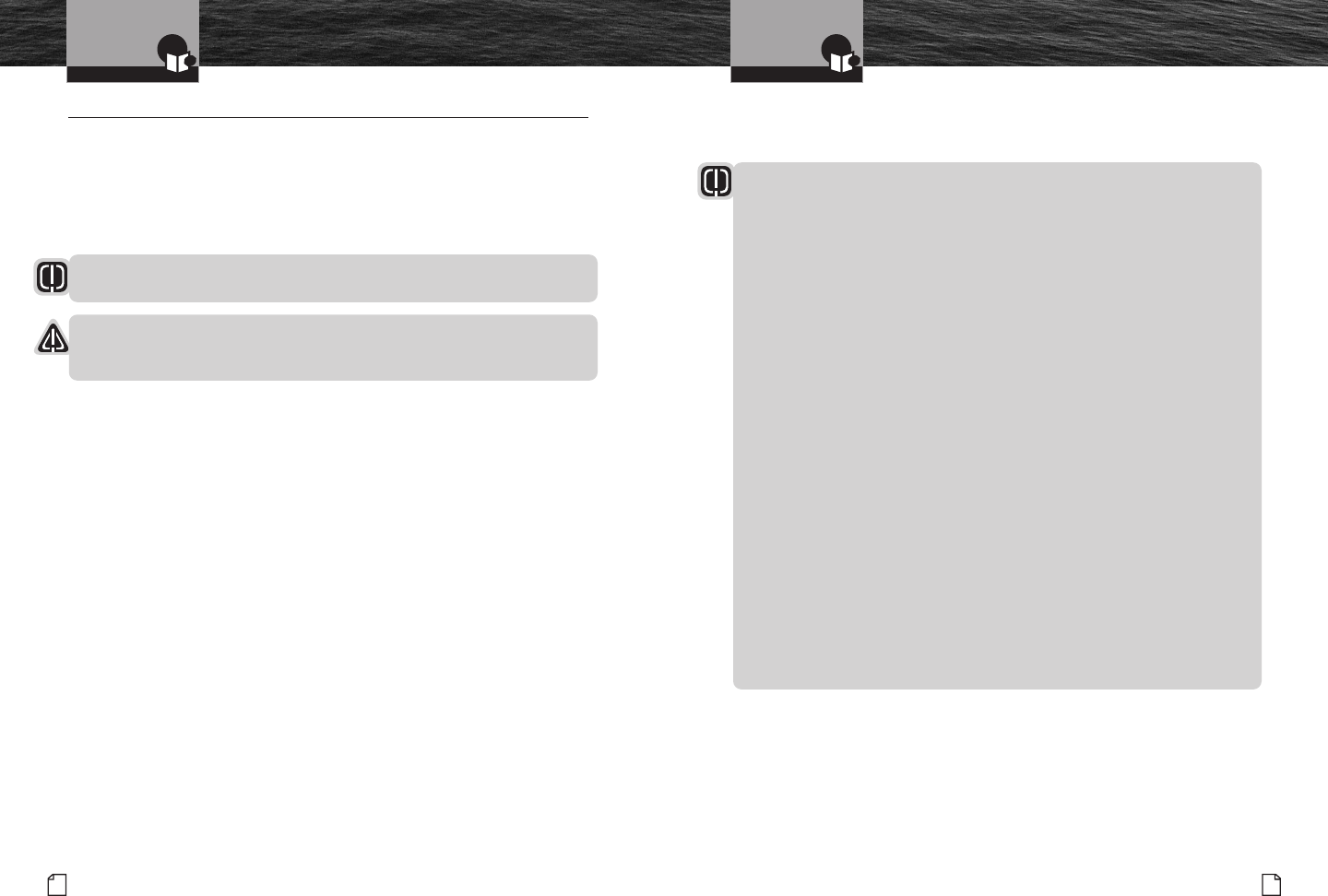
Introduction
3
Nothing comes close to a Cobra®
2English
Important Safety Information
Introduction Important Safety Information
The following WARNINGS and CAUTIONS will make you aware of RF exposure
hazards and how to assure you operate the radio within the FCC RF exposure
limits established for it.
WARNING
Your CobraMarine™radio generates electromagnetic RF (radio frequency)
energy when it is transmitting. To ensure that you and those around you are
not exposed to excessive amounts of that energy (beyond FCC allowable
limits for occupational use):
■ ALWAYS hold the radio, especially the antenna, at least two inches (5cm)
away from you when you are transmitting.
■ NEVER allow the antenna to touch any part of your body when transmitting.
■ KEEP the radio and antenna at least as far from bystanders as from yourself.
■ DO NOT operate the radio without the supplied antenna or a Cobra®authorized
replacement attached. In addition to the RF energy exposure hazard, doing so
may damage the radio.
■ DO NOT transmit more than 50% of the time the radio is in use — 50% duty
cycle. The radio is transmitting when the Talk button is pressed and the
Transmit icon shows on the LCD screen.
■ ALWAYS use only Cobra®authorized accessories (antennas, batteries,
belt clips, etc.).
■ DO NOT operate the radio where RF energy generated during transmission
may cause electromagnetic interference or incompatibility with other devices
or systems. This includes aircraft, blasting sites, and hospitals.
■ TURN OFF the radio in explosive atmospheres and where signs are posted
prohibiting radio transmissions.
Failure to observe any of these warnings may cause you to exceed
FCC RF exposure limits or create other dangerous conditions.
Important Safety Information •
Before assembling and using your CobraMarine™VHF radio,
please read these general precautions and warnings.
Warning and Caution Statements
To make the most of this radio, it must be assembled and used properly. Please read
the assembly and operating instructions carefully before assembling and using it.
Special attention must be paid to the WARNING and CAUTION statements in this manual.
WARNING
Statements identify conditions that could result in personal injury or loss of life.
CAUTION
Statements identify conditions that could cause damage to the radio
or other equipment.
Safety Training Information
This CobraMarine™radio is designed for and classified as “Occupational Use Only.”
It must only be used in the course of employment by individuals aware of both the
hazards and the ways to minimize those hazards. This radio is NOT intended for
use in an uncontrolled environment by the “General Population.”
This radio has been tested and complies with the FCC RF exposure limits for
“Occupational Use Only.” This CobraMarine™VHF radio also complies with the
following guidelines and standards regarding RF energy and electromagnetic
energy levels as well as evaluation of those levels for human exposure:
■ FCC OET Bulletin 65 Edition 97-01 Supplement C, Evaluating Compliance with
FCC Guidelines for Human Exposure to Radio Frequency Electromagnetic Fields.
■ American National Standards Institute (C95.1-1992), IEEE Standard for Safety
Levels with Respect to Human Exposure to Radio Frequency Electromagnetic
Fields, 3kHz to 300 GHz.
■ American National Standards Institute (C95.3-1992), IEEE Recommended
Practice for the Measurement of Potentially Hazardous Electromagnetic Fields —
RF and Microwave.
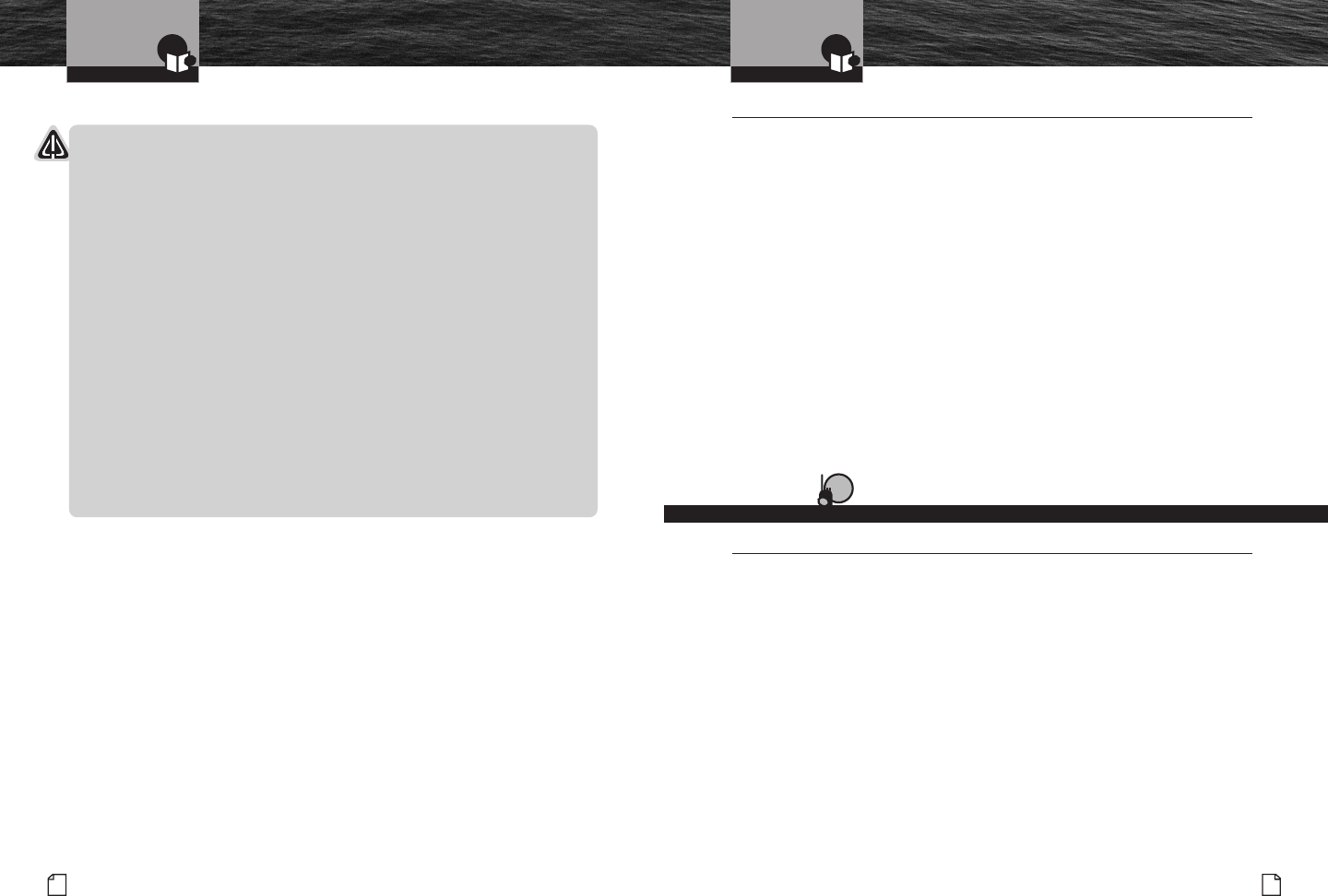
Introduction
5
Nothing comes close to a Cobra®
Recommendations for
Marine Communication
4English
Important Safety Information
Introduction
General Precautions
CAUTION
■ Your radio is waterproof only when the antenna and batteries
are properly installed.
■ Avoid using or storing the radio at temperatures below -4˚F (-20˚C)
or above 140˚F (60˚C).
■Keep your radio at least three (3) feet (0.9m) away from your
vessel’s magnetic navigation compass.
■ Do not attempt to service any internal parts yourself. Have any
necessary service performed by a qualified technician.
■Changes or modifications to your radio may void its compliance
with FCC rules and make it illegal to use.
■ This radio is supplied with six (6) NiMH (Nickel-Metal Hydride)
rechargeable batteries.
■ Use only the Cobra®charger to recharge NiMH batteries in the radio.
■ Do not short circuit the battery pack.
■ When replacing the batteries, dispose of the old batteries
properly. NiMH batteries may explode if disposed of in a fire.
Recommendations for Marine Communication •
The frequencies your radio uses are set aside to enhance safety afloat and for vessel
navigation and operational messages over a range suitable for nearshore voyages.
If the five (5) watt maximum output of your radio isn’t sufficient for the distances
you travel from the coast, consider installing a CobraMarine™fixed mount radio with up
to twenty-five (25) watts of output power. (Visit www.cobra.com or your local dealer
for model availability.)
If you will be going far offshore, you should consider adding even more powerful
radio equipment such as HF Single Sideband or Satellite Radio for your vessel.
The U.S. Coast Guard does not endorse cellular telephones as substitutes for marine
radios. They generally cannot communicate with rescue vessels and, if you make a
distress call on a cellular telephone, only the party you call will be able to hear you.
Additionally, cellular telephones may have limited coverage over water and can be
hard to locate. If you don’t know where you are, the Coast Guard will have difficulty
finding you if you’re using a cellular telephone.
However, cellular telephones can have a place on board — to allow social
conversations and keep the marine frequencies uncluttered and available for
their intended uses.
IMPORTANT NOTICE: FCC LICENSING INFORMATION •
CobraMarine™VHF radios comply with the FCC (Federal Communication
Commission) requirements that regulate the Maritime Radio Service.
Station License
An FCC ship station license is no longer required for any vessel traveling in U.S.A.
waters which uses a VHF marine radio, RADAR, or EPIRB (Emergency Position
Indicating Radio Beacon), and which is not required to carry radio equipment.
However, any vessel required to carry a marine radio on an international voyage,
carrying a HF single side band radiotelephone, or carrying a marine satellite
terminal must obtain a station license.
FCC license forms and applications for ship and land stations can be downloaded
through the internet at www.fcc.gov/forms. Forms can also be obtained by calling
the FCC at 888-225-5322.
VHF Marine Radio Protocols

7
Nothing comes close to a Cobra®
6English
FCC Information VHF Marine Radio
Procedures
Radio Call Sign
Currently, the FCC does not require recreational boaters to have a license. The United
States Coast Guard recommends that the boat’s registration number and state of registry
(e.g. Illinois 1234 AB) be used as a call sign and be clearly visible on the vessel.
Canadian Ship Station License
You may need a license if your vessel is operated in sovereign waters of a country
other than the U.S.A. If you are going to operate in Canadian waters, please contact
the nearest field office or write: Industry of Canada, Radio Regulatory Branch,
Attn: DOSP, 300 Slater Street, Ottawa, Ontario, Canada K1A 0C8.
User Responsibility and Operating Locations
All users are responsible for observing domestic and foreign government regulations
and are subject to severe penalties for violations. The VHF frequencies on your radio
are reserved for marine use and require a special license to operate from land,
including when your boat is on its trailer.
NOTE
This device complies with part 15 of the FCC Rules. Operation is subject to the
following two conditions: (1) This device may not cause harmful interference,
and (2) This device must accept any interference received, including interference
that may cause undesired operation.
FCC Warnings: Replacement or substitution of transistors, regular diodes, or other
parts of a unique nature, with parts other than those recommended by Cobra®may
cause a violation of the technical regulations of part 80 of the FCC Rules, or
violation of type acceptance requirements of part 2 of the Rules.
VHF Marine Radio Procedures •
Maintain Your Watch
Whenever your boat is underway, the radio must be turned On and
be tuned to Channel 16 except when being used for messages.
Power
Try one (1) watt first if the station being called is within a few miles. If there
is no answer, switch to a higher power. This will conserve your battery and
minimize interference to other users.
Calling Coast Stations
Call a coast station on its assigned channel. You may use Channel 16
when you do not know the assigned channel.
Calling Other Vessels
Call other vessels on Channel 16 or on Channel 9. (Channel 9 is preferred
for recreational vessel use.) You may also call on ship-to-ship channels
when you know that the vessel is listening on a ship-to-ship channel.
Limits On Calling
You must not call the same station for more than 30 seconds at a time.
If you do not get a reply, wait at least two (2) minutes before calling again.
After three (3) calling periods, wait at least 15 minutes before calling again.
Change Channels
After contacting another station on a calling channel, change immediately
to a channel which is available for the type of message you want to send.
Station Identification
Identify, in English, your station by your FCC call sign, ship name, the state registration
number, or other official number at both the beginning and end of each message.
Prohibited Communications
You MUST NOT transmit:
■ False distress or emergency messages.
■ Messages containing obscene, indecent, or profane words or meaning.
■ General calls, signals, or messages (messages not addressed to a particular
station) on Channel 16, except in an emergency or if you are testing your radio.
■ When you are on land.
VHF Marine Radio ProtocolsVHF Marine Radio Protocols
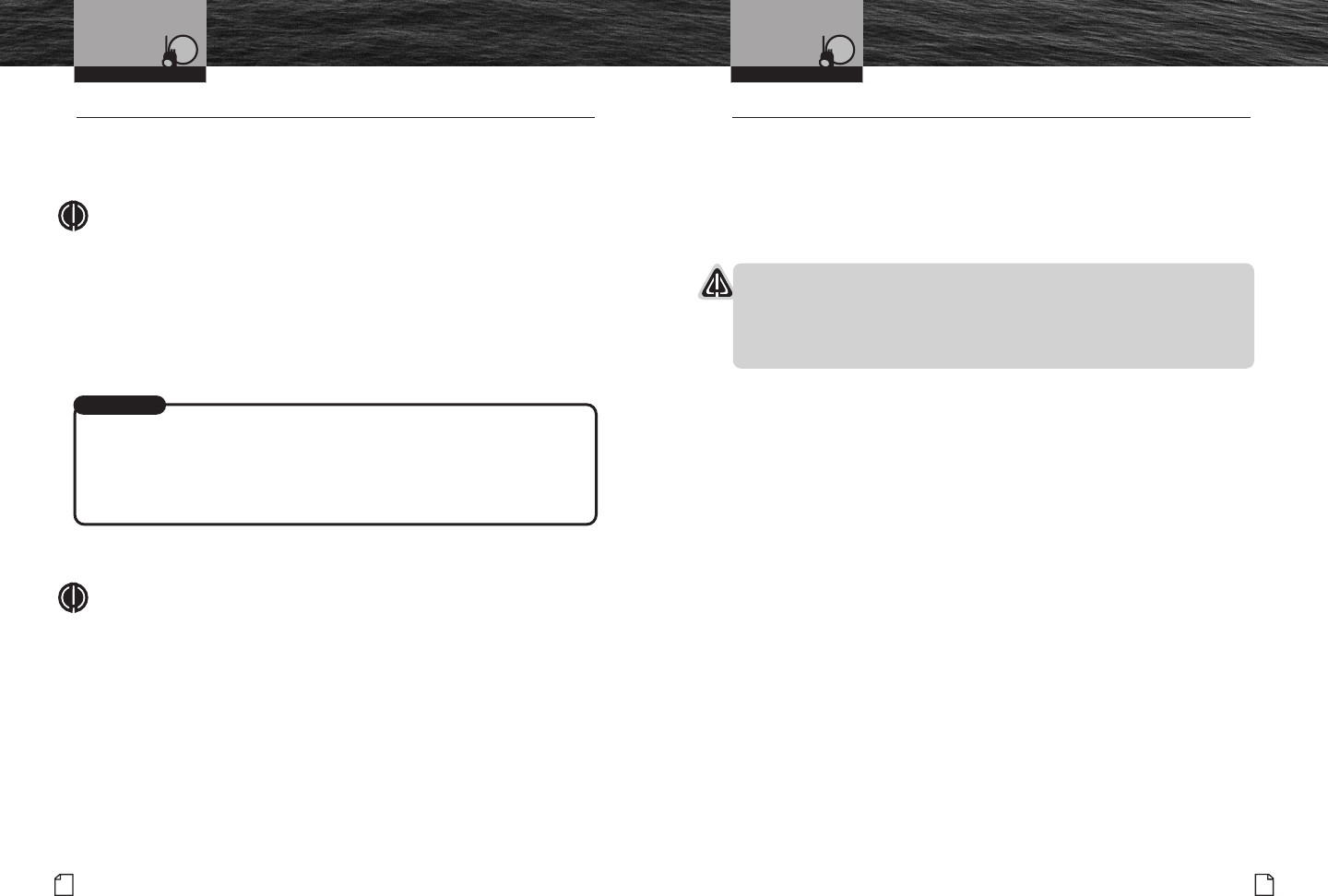
9
Nothing comes close to a Cobra®
8English
Voice Calling Radiotelephone Calls
Voice Calling •
To Call Another Vessel Or A Shore Installation Such As A Lock Or Bridge Tender:
■ Make sure your radio is On.
■ Select Channel 16 and listen to make sure it is not being used.
NOTE
Channel 9 may be used by recreational vessels for general-purpose calling. This
frequency should be used whenever possible to relieve congestion on Channel 16.
■ When the channel is quiet, press the Talk button and call the ship you wish to
call. (Hold the microphone a few inches from your face and speak directly into it
in a normal tone of voice — clearly and distinctly.) Say “[name of station being
called] THIS IS [your vessel’s name or call sign].”
■ Once contact is made on the calling channel, you must switch to
a proper working channel. See the channel listing on page 12.
The vessel Corsair calling the vessel Vagabond:
Corsair: “Vagabond, this is Corsair.”
Vagabond: “Corsair, this is Vagabond. Reply 72 (or any proper working channel).”
Corsair: “72” or “Roger”
■ After communications are completed, each vessel must sign off with its
call sign or vessel name and switch to Channel 16.
NOTE
For best sound quality at the station you are calling, hold the microphone on the
front of the radio at least two (2) inches [five (5) cm] from your mouth and slightly
off to one side. Speak in a normal tone of voice.
VHF Marine Radio Protocols VHF Marine Radio Protocols
For Example
Radiotelephone Calls •
Boaters may make and receive telephone calls to and from any number on the
telephone network by using the services of Public Coast Stations. Calls can be
made — for a fee — between your radio and telephones on land, sea, and in the air.
See pages 12 to 21 for the Public Correspondence (Marine Operator) channels.
If you plan to use these services, consider registering with the operator of the
Public Coast Station that you plan to work through. Those services can provide
you with detailed information and procedures to follow.
CAUTION
You may disclose privileged information during a radiotelephone call. Keep in mind
that your transmission is NOT private, as it is on a regular telephone. Both sides of
the conversation are being broadcast and can be heard by anyone who has a
radio and tunes to the channel you are using.
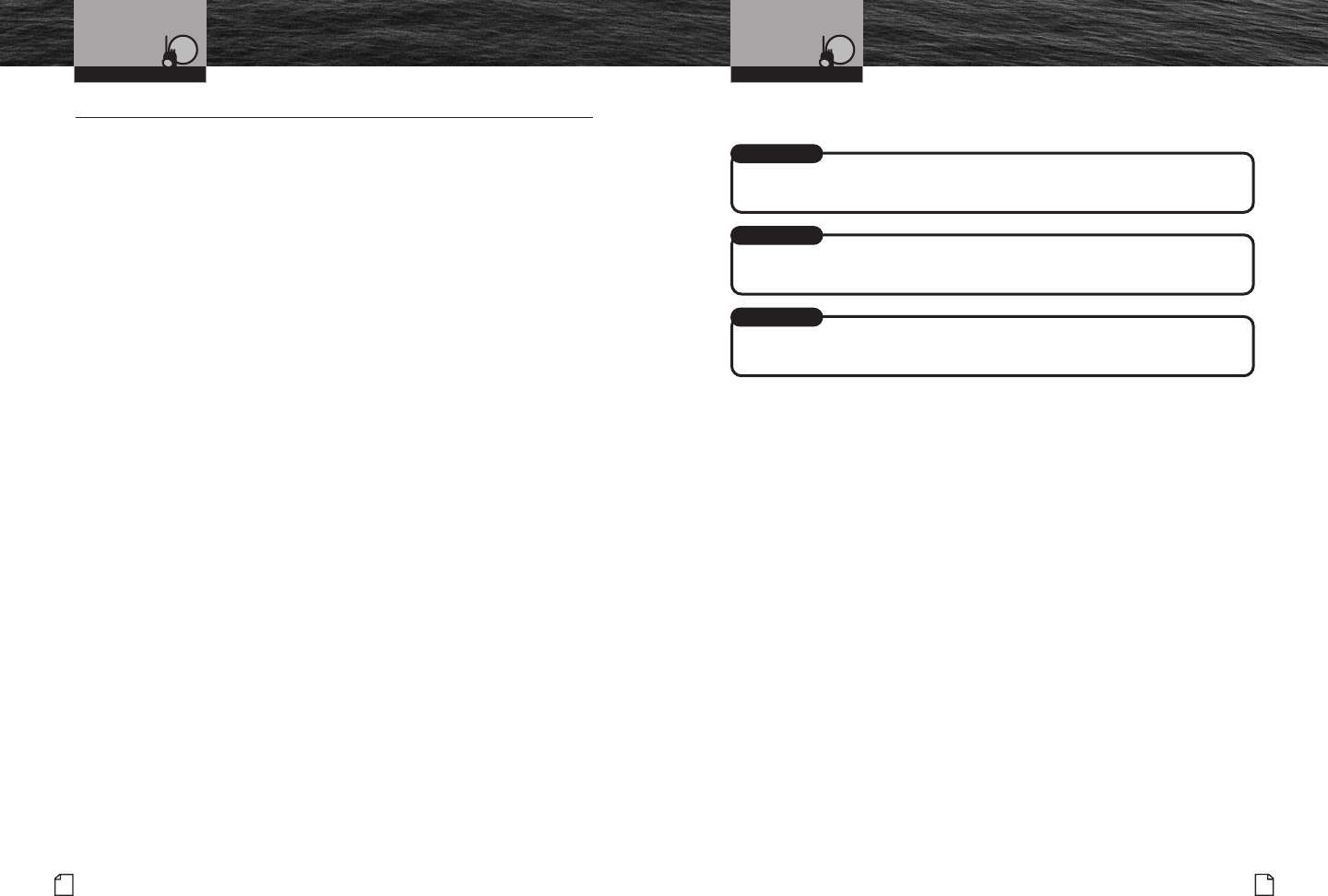
11
Nothing comes close to a Cobra®
10 English
Emergency Messages
and Distress Procedure Emergency Messages
and Distress Procedure
Emergency Messages and Distress Procedure •
The ability to summon assistance in an emergency is the primary reason
to have a VHF marine radio. The marine environment can be unforgiving,
and what may initially be a minor problem can rapidly develop into a
situation beyond your control.
The Coast Guard monitors Channel 16, responds to all distress calls,
and coordinates all search and rescue efforts. Depending on the availability
of other capable vessels or commercial assistance operators in your vicinity,
Coast Guard or Coast Guard Auxiliary craft may be dispatched.
In any event, do communicate with the Coast Guard (on Channel 22A) as
soon as you experience difficulties and before your situation becomes an
emergency. Use the emergency message procedures only after your situation
has become grave or you are faced with a sudden danger threatening life or
property and requiring immediate help. If you are merely out of gas, do not
send an emergency message. Drop your anchor and call a friend or marina
to bring the fuel you need or give you a tow.
Marine Emergency Signals
The three (3) spoken international emergency signals are:
The distress signal MAYDAY is used to indicate that a station is threatened
by grave and imminent danger and requests immediate assistance.
The urgency signal PAN is used when the safety of the vessel
or person is in jeopardy. (This signal is properly pronounced pahn.)
The safety signal SECURITE is used for messages about the safety of navigation or
important weather warnings. (This signal is properly pronounced see-cure-it-tay.)
When using an international emergency signal, the appropriate
signal is to be spoken three (3) times prior to the message.
If You Hear A Distress Call
You must give any message beginning with one (1) of these signals
priority over any other messages. ALL stations MUST remain silent on
Channel 16 for the duration of the emergency unless the message relates
directly to the emergency.
If you hear a distress message from a vessel, stand by your radio.
If it is not answered, YOU should answer. If the distressed vessel is
not nearby, wait a short time for others who may be closer to acknowledge.
Even if you cannot render direct assistance, you may be in a position to
relay the message.
VHF Marine Radio Protocols VHF Marine Radio Protocols
MAYDAY
PAN
SECURITE
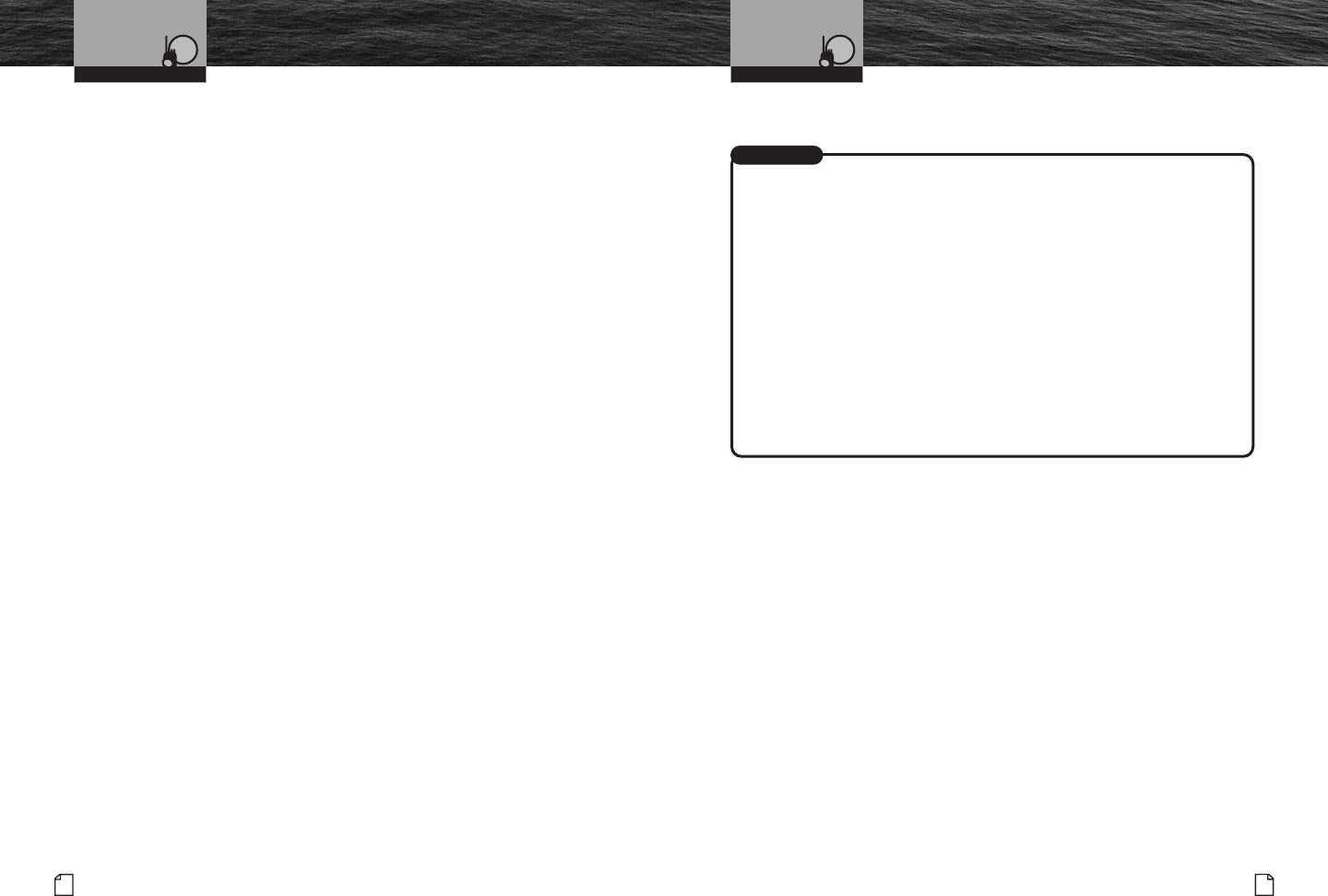
For Example
13
Nothing comes close to a Cobra®
Emergency Messages
and Distress Procedure
12 English
Emergency Messages
and Distress Procedure
Keep the radio nearby. Even after your message has been received, the Coast Guard
can find you more quickly if you can transmit a signal for a rescue boat to hone in on.
“Mayday — Mayday — Mayday”
“This is Corsair — Corsair — Corsair” (or “Illinois 1234 AB” three (3) times)
“Mayday Corsair (or Illinois 1234 AB)”
“Navy Pier bears 220 degrees magnetic — distance five (5) miles”
“Struck submerged object and flooding — need pump and tow”
“Four adults, three children aboard — no one injured”
“Estimate we will remain afloat one half (1⁄2) hour”
“Corsair (or Illinois 1234 AB) is 26 foot sloop with blue hull and tan deck house”
“I will be listening on Channel 16”
“This is Corsair (or Illinois 1234 AB)
“Over”
It is a good idea to write out a script of the message form and post it where you
and others on your vessel can see it when an emergency message needs to be sent.
VHF Marine Radio Protocols VHF Marine Radio Protocols
Marine Distress Procedure
Speak slowly — clearly — calmly.
1. Make sure your radio is On.
2. Select VHF Channel 16.
3. Press Talk button and say:
“MAYDAY — MAYDAY — MAYDAY.”
(Or “PAN — PAN — PAN,”
or “SECURITE — SECURITE — SECURITE.”)
4. Say:
“THIS IS [your vessel name or call sign].”
5. Say:
“MAYDAY (or “PAN” or “SECURITE”)
[your vessel name or call sign].
6. Tell where you are:
(what navigational aids or landmarks are near).
7. State the nature of your distress.
8. State the kind of assistance needed.
9. Give number of persons aboard and conditions of any injured.
10. Estimate present seaworthiness of your vessel.
11. Briefly describe your vessel (length, type, color, hull).
12. Say:
“I WILL BE LISTENING ON CHANNEL 16.”
13. End message by saying:
“THIS IS [your vessel name or call sign] OVER.”
14. Release Talk button and listen. Someone should answer.
If not, repeat the call, beginning at item 3 above.
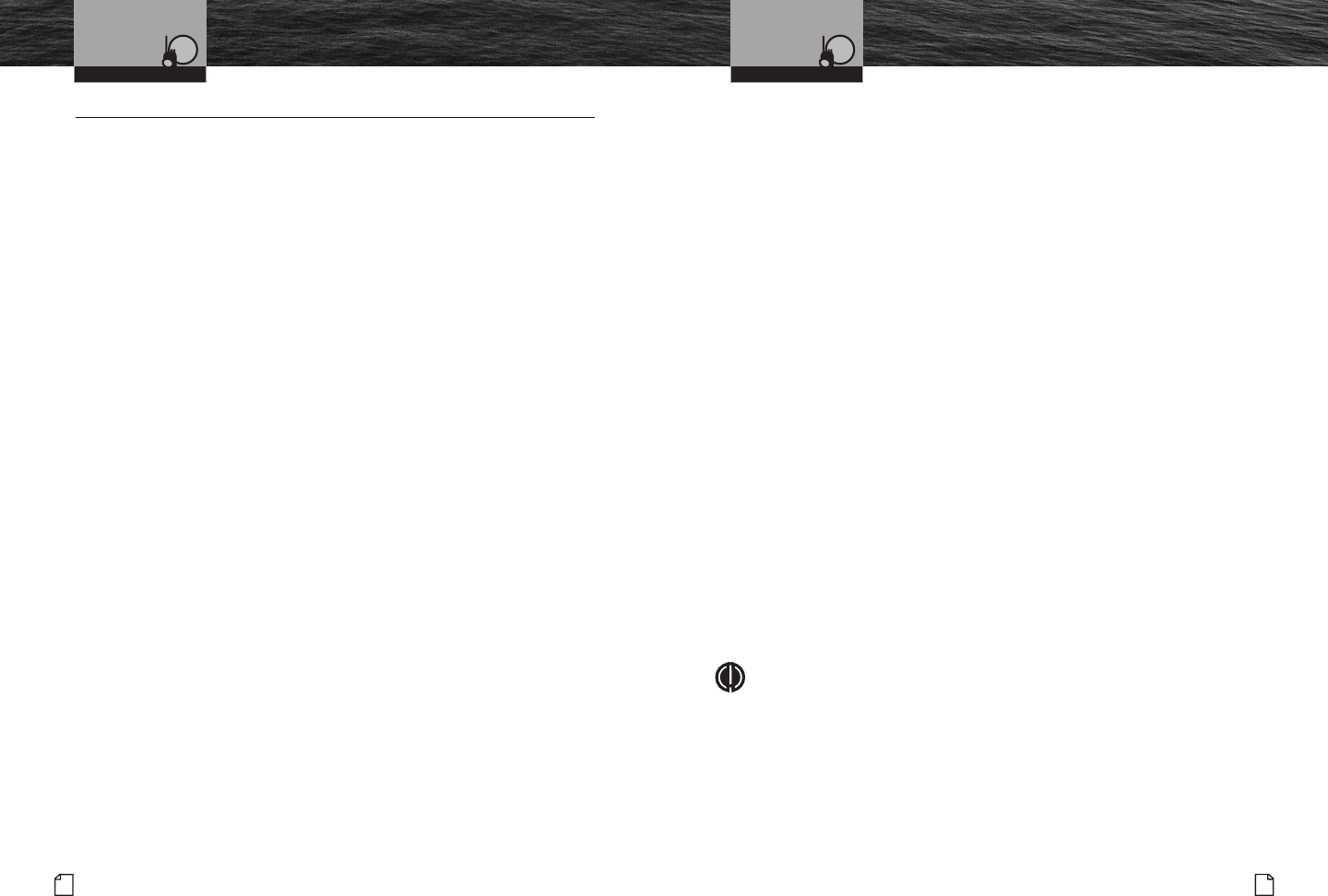
15
Nothing comes close to a Cobra®
VHF Marine
Channel Assignments
14 English
VHF Marine
Channel Assignments
VHF Marine Channel Assignments in the U.S.A. •
Distress, Safety, and Calling
Channel 16
Getting the attention of another station (calling) or in emergencies
(distress and safety).
Calling
Channel 9
General purpose (non-emergency) calling by non-commercial vessels.
Recreational boaters are urged to use this channel to reduce congestion
on Channel 16.
Intership Safety
Channel 6
Ship-to-ship safety messages and for search and rescue messages to
Coast Guard ships and aircraft.
Coast Guard Liaison
Channel 22A
To talk to the Coast Guard (non-emergency) after making contact on Channel 16.
Non-Commercial
Channels 68*, 69, 71, 72, 78, 79*, 80*
Working channels for small vessels. Messages must be about needs of the
vessel, such as fishing reports, berthing, and rendezvous. Use Channel 72 only
for ship-to-ship messages.
Commercial
Channels 1, 7, 8, 9, 10, 11, 18, 19, 63, 67, 72, 79, 80, 88*
Working channels for working ships only. Messages must be about business or
needs of the ship. Use Channels 8, 67, 72, and 88 only for ship-to-ship messages.
Public Correspondence (Marine Operator)
Channels 24, 25, 26, 27, 28, 84, 85, 86, 87, 88*
For calls to marine operators at public coast stations. You can make and receive
telephone calls through these stations.
Port Operations
Channels 1*, 5*, 11, 12*, 14*, 20, 63*, 65, 66, 73, 74, 77*
Used for directing the movement of ships in or near ports, locks, or waterways.
Messages must be about operational handling, movement, and safety of ships.
Navigational
Channels 13, 67
Channels are available to all vessels. Messages must be about navigation,
including passing or meeting other vessels. These are also the main working
channels for most locks and drawbridges. You must keep your messages
short and power output at no more than one (1) watt.
Maritime Control
Channel 17
For talking to vessels and coast stations operated by state or local governments.
Messages must be about regulation and control, boating activities, or assistance.
Digital Selective Calling
Channel 70
This channel is set aside for distress, safety, and general calling using only digital
selective calling techniques. Voice communication is prohibited; your radio cannot
transmit voice messages on this channel.
Weather
Channels Wx 1 thru 10
Receive-only channels for NOAA weather broadcasts. You cannot transmit on them.
NOTE
*These channels are restricted to the listed uses in certain parts of
the country or for certain types of users only. Consult FCC rules
or a knowledgeable radio operator before using them.
VHF Marine Radio Protocols VHF Marine Radio Protocols
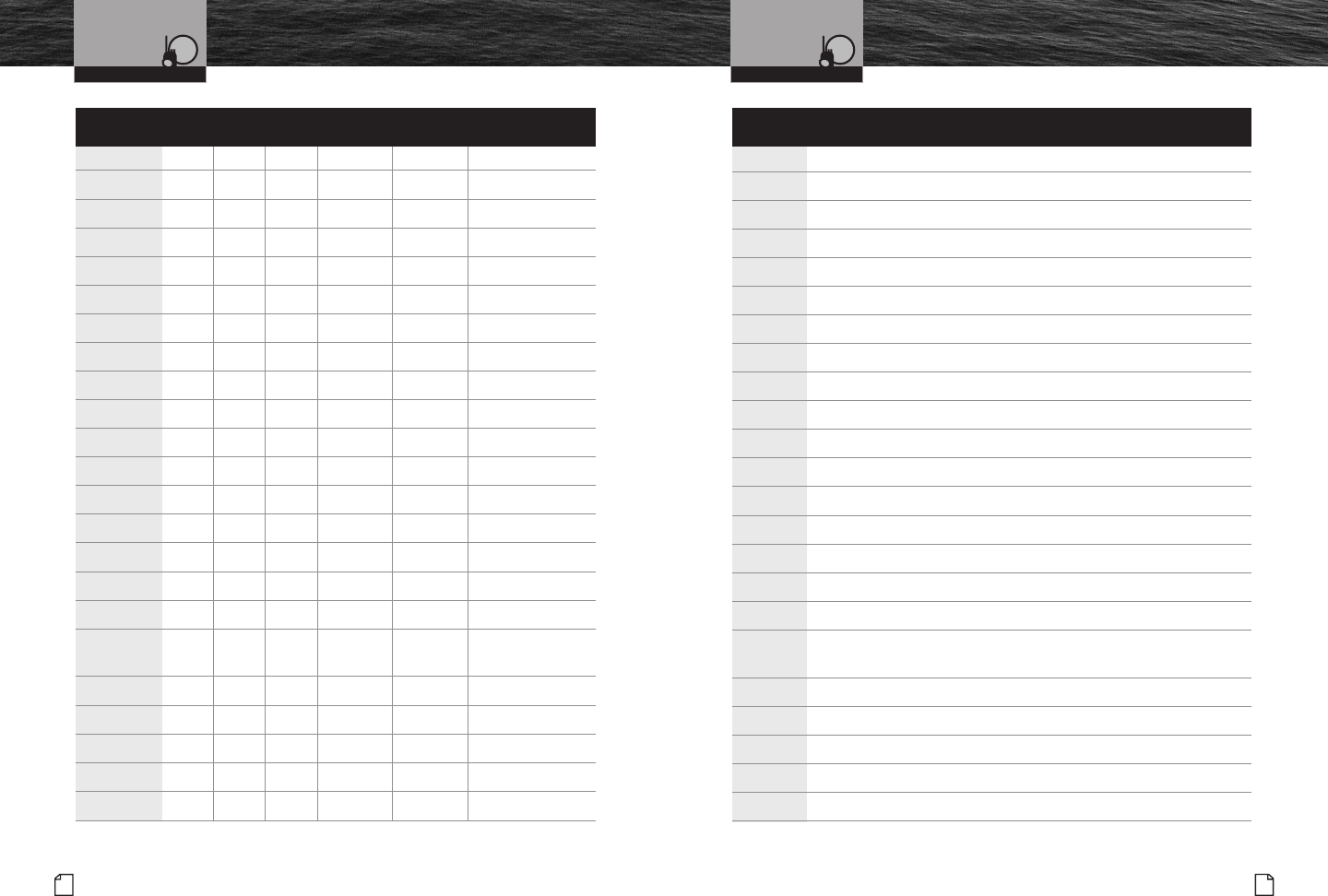
16 English
VHF Marine
Channel Assignments
VHF Marine Radio Protocols
17
Nothing comes close to a Cobra®
VHF Marine
Channel Assignments
VHF Marine Radio Protocols
Channel Channel Map Frequency Power
Number USA Int’l Canada Transmit Receive Limits
01 ••
156.050 160.650
01A •156.050 156.050
02 ••156.100 160.700
03 ••156.150 160.750
03A •156.150 156.150
04 •156.200 160.800
04A •156.200 156.200
05 •156.250 160.850
05A ••156.250 156.250
06 •••156.300 156.300
07 •156.350 160.950
07A ••156.350 156.350
08 •••156.400 156.400
09 •••156.450 156.450
10 •••156.500 156.500
11 •••156.550 156.550
12 •••156.600 156.600
13 •••
156.650 156.650 1 Watt USA and CAN
14 •••156.700 156.700
15 •Rx Only 156.750
15 ••156.750 156.750 1 Watt CAN and INT
16 •••156.800 156.800
17 •••156.850 156.850 1 Watt USA and CAN
Channel Use
01 Public Correspondence (Marine Operator)
01A Port Operations and Commercial, VTS in selected areas
02 Public Correspondence (Marine Operator)
03 Public Correspondence (Marine Operator)
03A Government Only
04 Public Correspondence (Marine Operator), Port Operations, Ship Movement
04A West Coast (Coast Guard Only); East Coast (Commercial Fishing)
05 Public Correspondence (Marine Operator), Port Operations, Ship Movement
05A Port Operations, VTS in selected areas
06 Intership Safety
07 Public Correspondence (Marine Operator), Port Operations, Ship Movement
07A Commercial
08 Commercial (Intership Only)
09 Boater Calling Channel, Non-Commercial (Recreational)
10 Commercial
11 Commercial, VTS in selected areas
12 Port Operations, VTS in selected areas
13 Intership Navigation Safety (Bridge-to-Bridge). In U.S. waters,
large vessels maintain a listening watch on this channel.
14 Port Operations, VTS in selected areas
15 Environmental (Receive Only). Used by class C EPIRB’s.
15 Canada (EPIRB Buoys Only); International (On-Board Communication)
16 International Distress, Safety and Calling
17 State Controlled (U.S.A. Only)
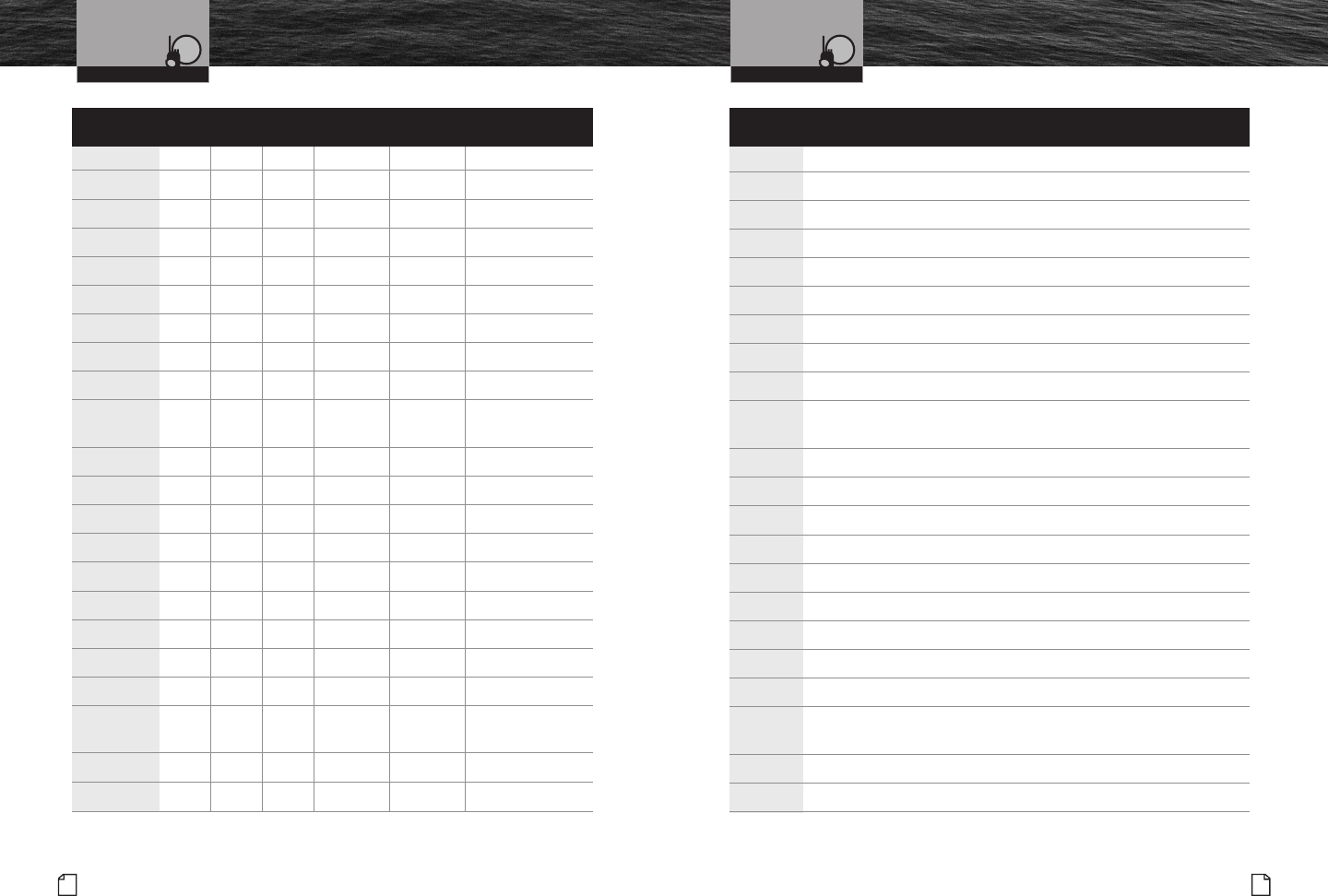
19
Nothing comes close to a Cobra®
VHF Marine
Channel Assignments
18 English
VHF Marine
Channel Assignments
VHF Marine Radio Protocols VHF Marine Radio Protocols
Channel Use
18 Port Operations, Ship Movement
18A Commercial
19 Port Operations, Ship Movement
19A Commercial
20 Canada (Coast Guard Only); International (Port Operations, Ship Movement)
20A Port Operations
21 Port Operations, Ship Movement
21A U.S. (Government Only); Canada (Coast Guard Only)
22 Port Operations, Ship Movement
22A U.S. and Canadian Coast Guard Liaison and Maritime Safety Information
Broadcasts that are announced on Channel 16
23 Public Correspondence (Marine Operator)
23A Government Only
24 Public Correspondence (Marine Operator)
25 Public Correspondence (Marine Operator)
26 Public Correspondence (Marine Operator)
27 Public Correspondence (Marine Operator)
28 Public Correspondence (Marine Operator)
60 Public Correspondence (Marine Operator)
61 Public Correspondence (Marine Operator), Port Operation, Ship Movement
61A U.S. (Government Only); Canada (Coast Guard Only);
West Coast (Coast Guard Only); East Coast (Commercial Fishing)
62 Public Correspondence (Marine Operator), Port Operations, Ship Movement
62A West Coast (Coast Guard Only); East Coast (Commercial Fishing)
Channel Channel Map Frequency Power
Number USA Int’l Canada Transmit Receive Limits
18 •156.900 161.500
18A ••
156.900 156.900
19 •156.950 161.550
19A ••
156.950 156.950
20 •••
157.000 161.600 1 Watt CAN
20A •157.000 157.000
21 ••
157.050 161.650
21A ••
157.050 157.050
22 •157.100 161.700
22A ••
157.100 157.100
23 ••
157.150 161.750
23A •157.150 157.150
24 •••
157.200 161.800
25 •••
157.250 161.850
26 •••
157.300 161.900
27 •••
157.350 161.950
28 •••
157.400 162.000
60 ••
156.025 160.625
61 •156.075 160.675
61A ••
156.075 156.075
62 •156.125 160.725
62A • 156.125 156.125
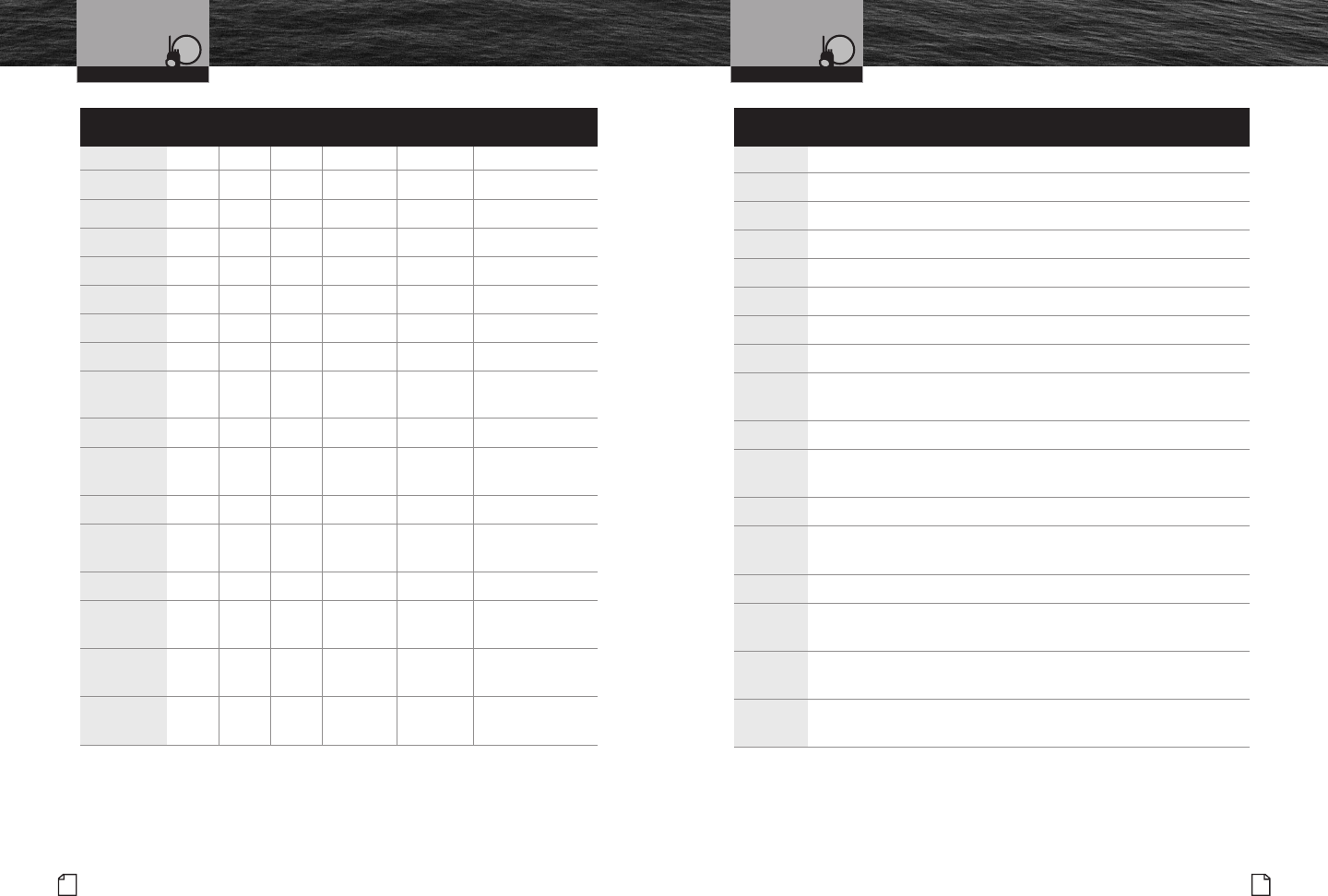
21
Nothing comes close to a Cobra®
VHF Marine
Channel Assignments
20 English
VHF Marine
Channel Assignments
VHF Marine Radio Protocols VHF Marine Radio Protocols
Channel Channel Map Frequency Power
Number USA Int’l Canada Transmit Receive Limits
63 •156.175 160.775
63A •156.175 156.175
64 ••
156.225 160.825
64A ••
156.225 156.225
65 •156.275 160.875
65A •••
156.275 156.275
66 •156.325 160.925
66A •••
156.325 156.325 1 Watt CAN
67 •••
156.375 156.375 1 Watt USA
68 •••
156.425 156.425
69 •••
156.475 156.475
70 •••
RX only 156.525
71 •••
156.575 156.575
72 •••
156.625 156.625
73 •••
156.675 156.675
74 •••
156.725 156.725
77 •••
156.875 156.875 1 Watt USA and CAN
Channel Use
63 Public Correspondence (Marine Operator), Port Operations, Ship Movement
63A Port Operations and Commercial, VTS in selected areas
64 Public Correspondence (Marine Operator), Port Operations, Ship Movement
64A U.S. (Government Only); Canada (Commercial Fishing)
65 Public Correspondence (Marine Operator), Port Operations, Ship Movement
65A Port Operations
66 Public Correspondence (Marine Operator), Port Operations, Ship Movement
66A Port Operations
67 U.S. (Commercial). Used for bridge-to-bridge communications in lower
Mississippi River (Intership Only); Canada (Commercial Fishing), S&R
68 Non-Commercial (Recreational)
69 U.S. (Non-Commercial, Recreational); Canada (Commercial Fishing Only);
International (Intership, Port Operations, Ship Movement)
70 Digital Selective Calling (Voice communications not allowed)
71 U.S. and Canada (Non-Commercial, Recreational);
International (Port Operations, Ship Movement)
72 Non-Commercial (Intership Only)
73 U.S. (Port Operations); Canada (Commercial Fishing Only);
International (Intership, Port Operations, Ship Movement)
74 U.S. (Port Operations); Canada (Commercial Fishing Only);
International (Intership, Port Operations, Ship Movement)
77 Port Operations (Intership only). Restricted to communications
with pilots for movement and docking of ships.
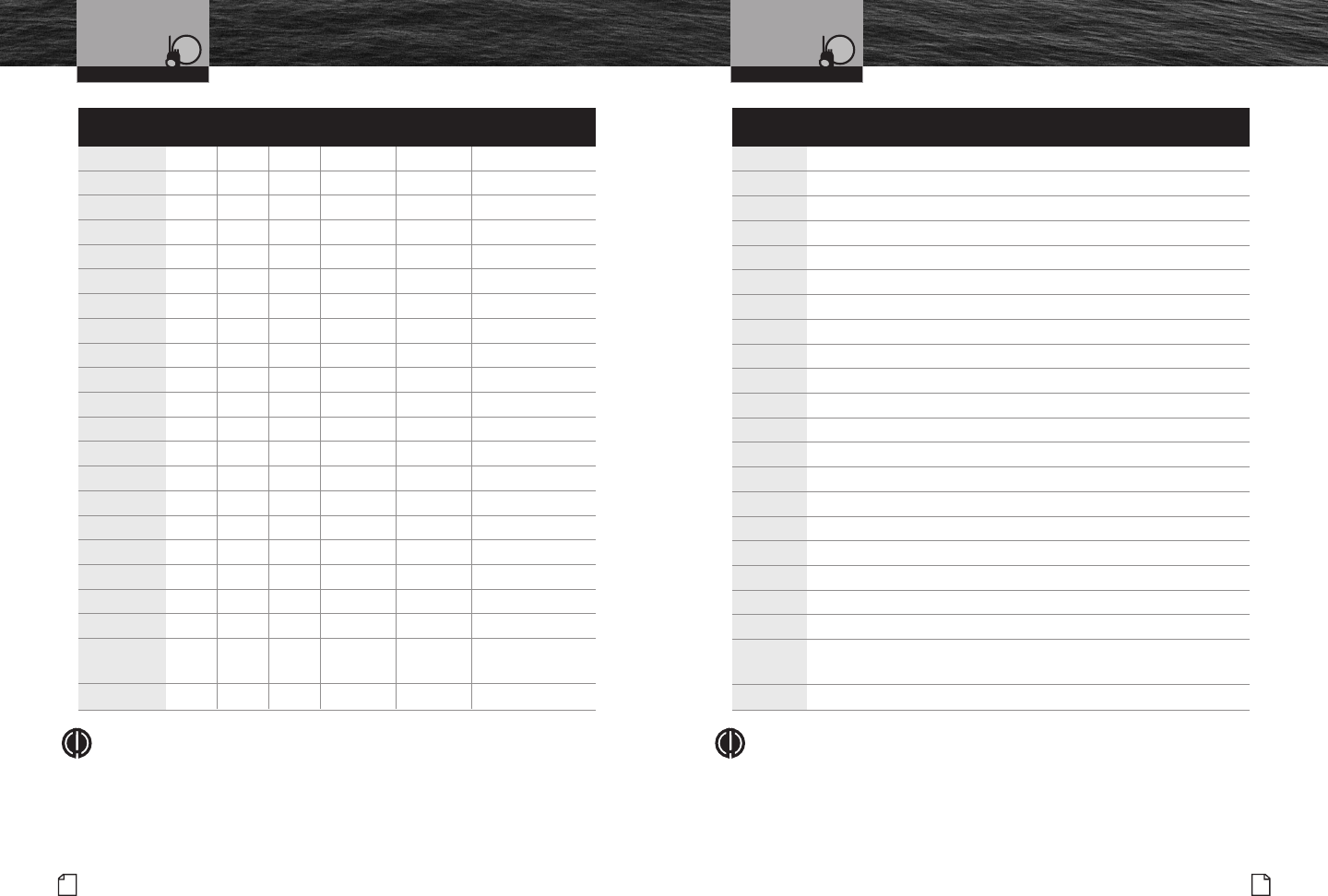
Channel Channel Map Frequency Power
Number USA Int’l Canada Transmit Receive Limits
78 •156.925 161.525
78A ••
156.925 156.925
79 •156.975 161.575
79A ••
156.975 156.975
80 •157.025 161.625
80A ••
157.025 157.025
81 •157.075 161.675
81A ••
157.075 157.075
82 •157.125 161.725
82A ••
157.125 157.125
83 ••
157.175 161.775
83A ••
157.175 157.175
84 •••
157.225 161.825
84A •157.225 157.225
85 •••
157.275 161.875
85A •157.275 157.275
86 •••
157.325 161.925
86A •157.325 157.325
87 •••
157.375 161.975
87A •157.375 157.375
88 •••
157.425 162.025
88A •157.425 157.425
NOTE
Many of the plain numbered channels, such as 1, 2, and 3, transmit and receive
on different frequencies. This is termed duplex operation. The rest of the plain
numbered channels and all of the A channels, such as 01A, 03A, and 04A,
transmit and receive on a single frequency, which is termed simplex operation.
Your radio automatically adjusts to these conditions. When in simplex operation,
the A icon will appear on the LCD (see illustration on page A3).
23
Nothing comes close to a Cobra®
VHF Marine
Channel Assignments
22 English
VHF Marine
Channel Assignments
Channel Use
78 Public Correspondence (Marine Operator)
78A Non-Commercial (Recreational)
79 Port Operations, Ship Movement
79A Commercial (Also Non-Commercial only in Great Lakes)
80 Port Operations, Ship Movement
80A Commercial (Also Non-Commercial only in Great Lakes)
81 Port Operations, Ship Movement
81A U.S. (Government Only; Environmental Protection Operations)
82 Public Correspondence (Marine Operator), Port Operation, Ship Movement
82A U.S. (Government Only); Canada (Coast Guard Only)
83 Canada (Coast Guard Only)
83A U.S. (Government Only); Canada (Coast Guard Only)
84 Public Correspondence (Marine Operator)
84A Public Correspondence (Marine Operator)
85 Public Correspondence (Marine Operator)
85A Public Correspondence (Marine Operator)
86 Public Correspondence (Marine Operator)
86A Public Correspondence (Marine Operator)
87 Public Correspondence (Marine Operator)
87A Public Correspondence (Marine Operator)
88 Public Correspondence (Ship to Coast). In U.S. only within
75 miles of Canadian Border.
88A Commercial Intership only
NOTE
All channels are pre-programmed at the factory according to international
regulations and those of the FCC (U.S.A.) and Industry Canada (Canada).
They cannot be altered by the user nor can modes of operation be changed
between simplex and duplex.
VHF Marine Radio Protocols VHF Marine Radio Protocols
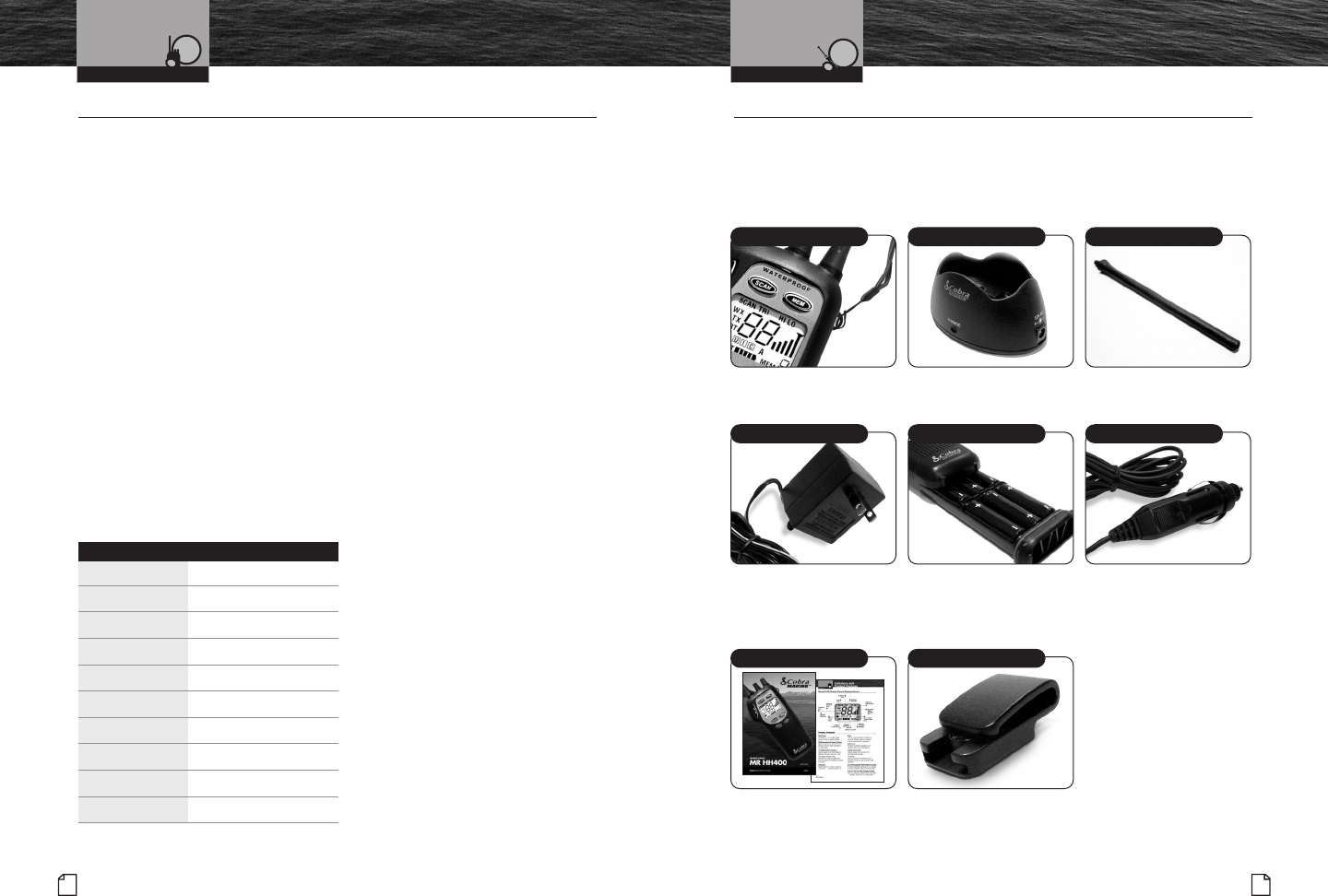
25
Nothing comes close to a Cobra®
24 English
NOAA Weather Channels Included in This Package
NOAA Weather Channels •
Monitoring the weather will probably be a frequent use of your radio. The National
Oceanic and Atmospheric Administration (NOAA) provides continuous, around-the-clock
broadcasts of the latest weather information. Taped weather messages run every four (4)
to six (6) minutes and are revised every two (2) or three (3) hours, or as needed. The Coast
Guard also announces weather and other safety warnings on Channel 16, and then
broadcasts the warning on Channel 22A. Smart boaters keep an eye on safety and
an ear to the radio — and never let the weather catch them unaware.
NOAA Emergency Weather Alert
In the event of a major storm or other weather condition requiring vessels at sea or on
other bodies of water to be notified, NOAA broadcasts a 1050 Hz tone that receivers
such as your CobraMarine™VHF radio can detect and warn you of a Weather Alert
Condition. When the Weather Alert mode on your radio is On, this signal will produce
a loud tone from the speaker in the radio and a flashing “ALRT” icon on the LCD to
signal that a weather alert is being broadcast. To hear the warning itself, you will need
to switch to the Weather Channel you selected.
Test
To test this system, NOAA broadcasts the 1050 Hz signal every Wednesday sometime
between 11 a.m. and 1 p.m. in each local time zone. Any receiver that can detect the
weather alert tone may use this feature to verify that this feature is functioning properly.
Weather Frequency
Channel RX Frequency MHz
1 162.550
2 162.400
3 162.475
4 162.425
5 162.450
6 162.500
7 162.525
8 161.650
9 161.775
10 163.275
Included in This Package •
You should find all of the following items in the
package with your CobraMarine™VHF radio:
Radio With Wrist Strap Drop-In Battery Charger Flexible Antenna
Battery Charger Power Cord
For connection to 120 volt
wall outlet.
Battery Tray
With 6 AA NiMH batteries.
Battery Charger Power Cord
For connection to 12 volt
source through cigarette
lighter.
Operating Instruction Manual Belt Clip
VHF Marine Radio Protocols Installation
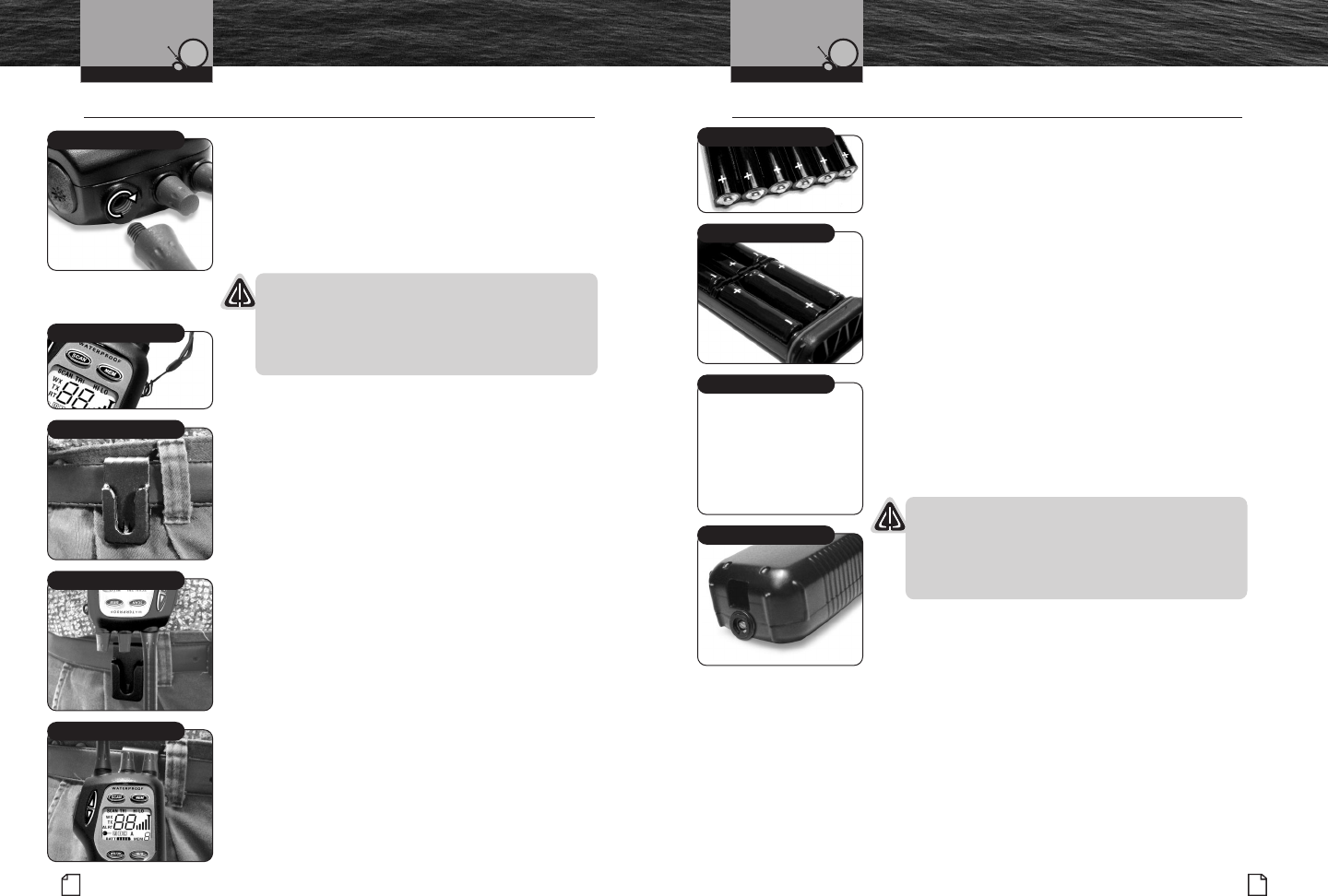
27
Nothing comes close to a Cobra®
26 English
Antenna, Wrist Strap,
and Belt Clip
Installation Batteries and Charger
Antenna, Wrist Strap, and Belt Clip •
Antenna Installation
The flexible antenna for the radio is shipped separately in
the package and must be attached before you use the radio.
1. Align the base of the antenna with the socket in the
top of the radio.
2. Screw it all the way into the socket. Be sure that
the seal seats properly.
CAUTION
Operating the radio without the antenna in place
may damage the unit. The radio is not waterproof
until the antenna and battery pack are in place
with their seals properly seated.
Wrist Strap
Your radio comes with the wrist strap already attached.
It can be easily removed if you choose not to use it.
Belt Clip
Use the belt clip to carry your radio around with you.
1. Slide the clip onto your belt.
2. Insert the knob on the back of the radio into the
channel on the back of the belt clip. You must
have the radio upside-down, as shown, to insert
or remove it from the belt clip.
3. Once the knob has been inserted all the way into
the belt clip channel, the radio will swing freely
while being securely retained.
Installation
Batteries and Charger •
The radio is shipped with six (6) rechargeable
NiMH (Nickel-Metal Hydride) batteries in the
package. It will also operate with six (6) high
quality alkaline batteries.
Installing the Batteries
1. Open the battery compartment by turning the
screw counter-clockwise one-quarter (1⁄4) turn.
2. Slide the empty battery tray out of the radio.
3. Align the batteries with the slots in the battery
tray and insert them. Be sure to match the polarity
markings on the batteries with those on the tray.
4. Slide the full battery tray into the radio. Be sure
the seal is in its groove and not pinched between
the tray and the body of the radio.
5. Turn the screw one-quarter (1⁄4) turn clockwise to
lock the battery tray in place.
After the NiMH batteries are installed in the radio,
they will need to be charged before they can be used.
CAUTION
The gasket on the base of the battery pack is
essential for the radio to be waterproof. Be certain
that it is not dislodged and that it fits properly
into the radio.
Initial Charge
The Cobra®provided NiMH batteries can be charged
at home, in your automobile, or in your boat using the
appropriate 12 or 120 volt power cord with the charger.
Install Antenna
Install Batteries
Improper Sealing
Proper Sealing
Six (6) Rechargeable Batteries
Wrist Strap
Slide Belt Clip Onto Belt
Insert Knob Onto Belt Clip
Secured Radio
Sealing Tray Image
to Come From Cobra.
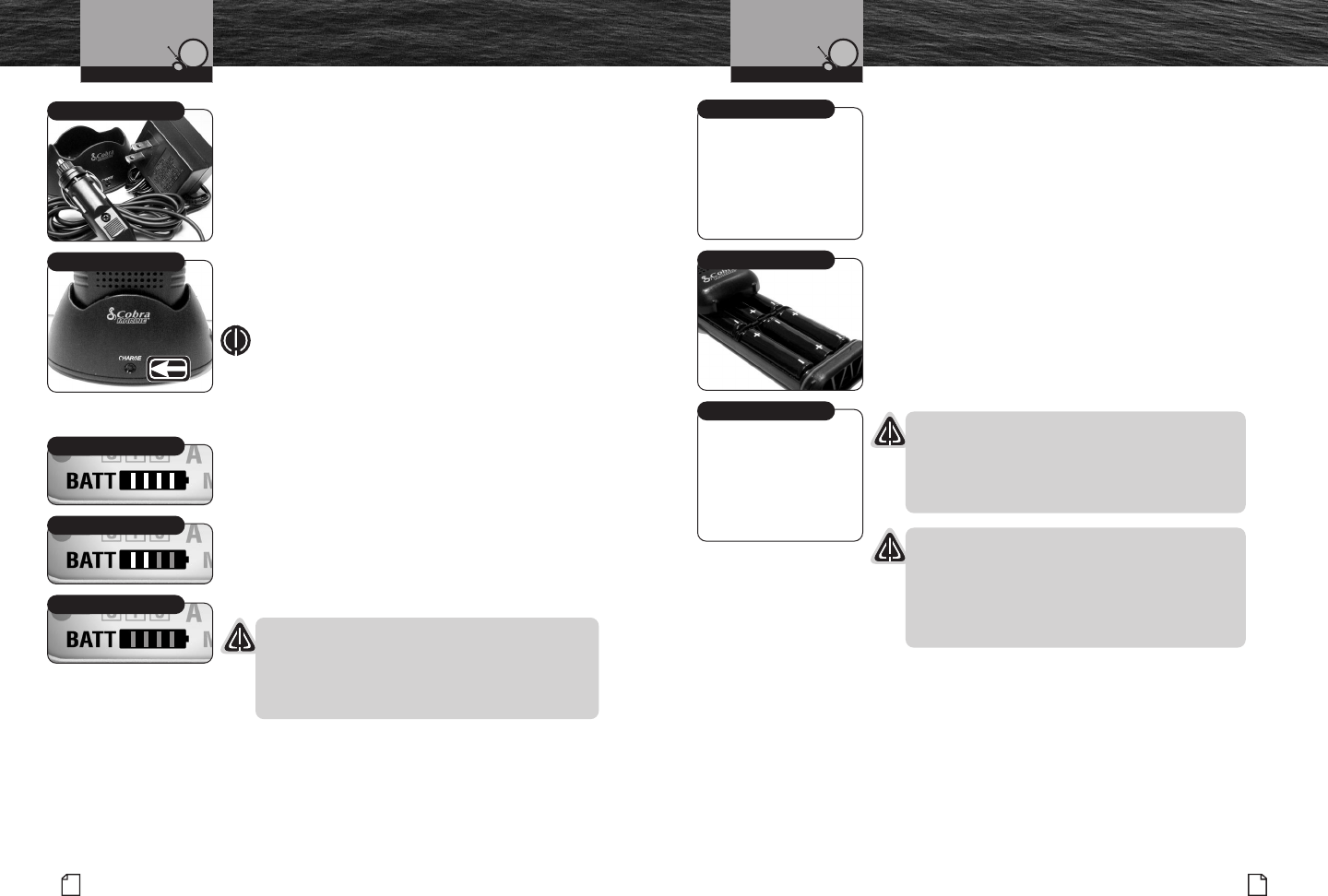
29
Nothing comes close to a Cobra®
28 English
Batteries and Charger Batteries and Charger
1. Insert one of the power cords into the back of the
drop-in charging cradle.
2. Insert the other end of the power cord into the
appropriate 12 or 120 volt power source.
3. Insert the radio into the charger. The metal pads
on the radio will contact mating pads in the charger
to transfer the charging current.
4. Observe that the red light on the front of the charger
glows to indicate that the radio is properly seated and
the charger is operating.
5. Allow the batteries to charge for 12 to 15 hours.
NOTE
If the drop-in charger is to be used on a boat,
Cobra® recommends you attach it to a shelf or
bulkhead (using the screw holes provided) to
prevent damage due to the boat rolling or pitching.
Maintaining the Battery Charge
As you use your radio, the battery power icon will
show the battery power remaining. When the icon
shows only one or no segment, it is time to recharge
or change the batteries.
You can monitor incoming calls while the radio is
charging. However, you should remove it from the
charger to transmit. Charging will be quicker if the
radio is turned Off.
CAUTION
Use only the drop-in charger provided by Cobra®.
Do not use the charger with alkaline batteries; only
the NiMH batteries are rechargeable. Spent alkaline
batteries must be discarded and replaced.
It is a good idea to keep a set of fresh, high quality
alkaline batteries with your radio. Should the rechargeable
batteries become discharged and no electrical power
source be available, you can insert the alkaline batteries
and continue to use your radio until you can return to
using the rechargeable ones.
Installation Installation
Replacing the Batteries
When your rechargeable batteries begin to
discharge too quickly, it is time to install new ones.
1. Obtain six (6) replacement AA size NiMH
batteries. (See Optional Accessories page 46.)
2. Open the battery compartment by turning the
screw counter-clockwise one-quarter turn.
3. Slide the battery holder out of the radio and
remove the old batteries.
4. Install the new batteries in the holder.
Be sure to match the polarity markings
on the batteries with those on the tray.
5. Insert the battery pack in the radio.
6. Close the battery compartment by turning
the screw one quarter-turn clockwise.
CAUTION
The gasket on the base of the battery pack is
essential for the radio to be waterproof. Be certain
that it is not dislodged while changing the batteries
and fits properly into the radio.
CAUTION
NiMH batteries are toxic. Please dispose of the
old ones properly. Some marine suppliers accept
old batteries for recycling and many municipal
waste disposal agencies have special provisions
for battery disposal.
Fully Charged
Partially Charged
Fully Discharged
Open Battery Compartment
Image to Follow From Cobra.
Image to Follow From Cobra.
Install New Batteries
Close Battery Compartment
Power Sources
Insert Radio
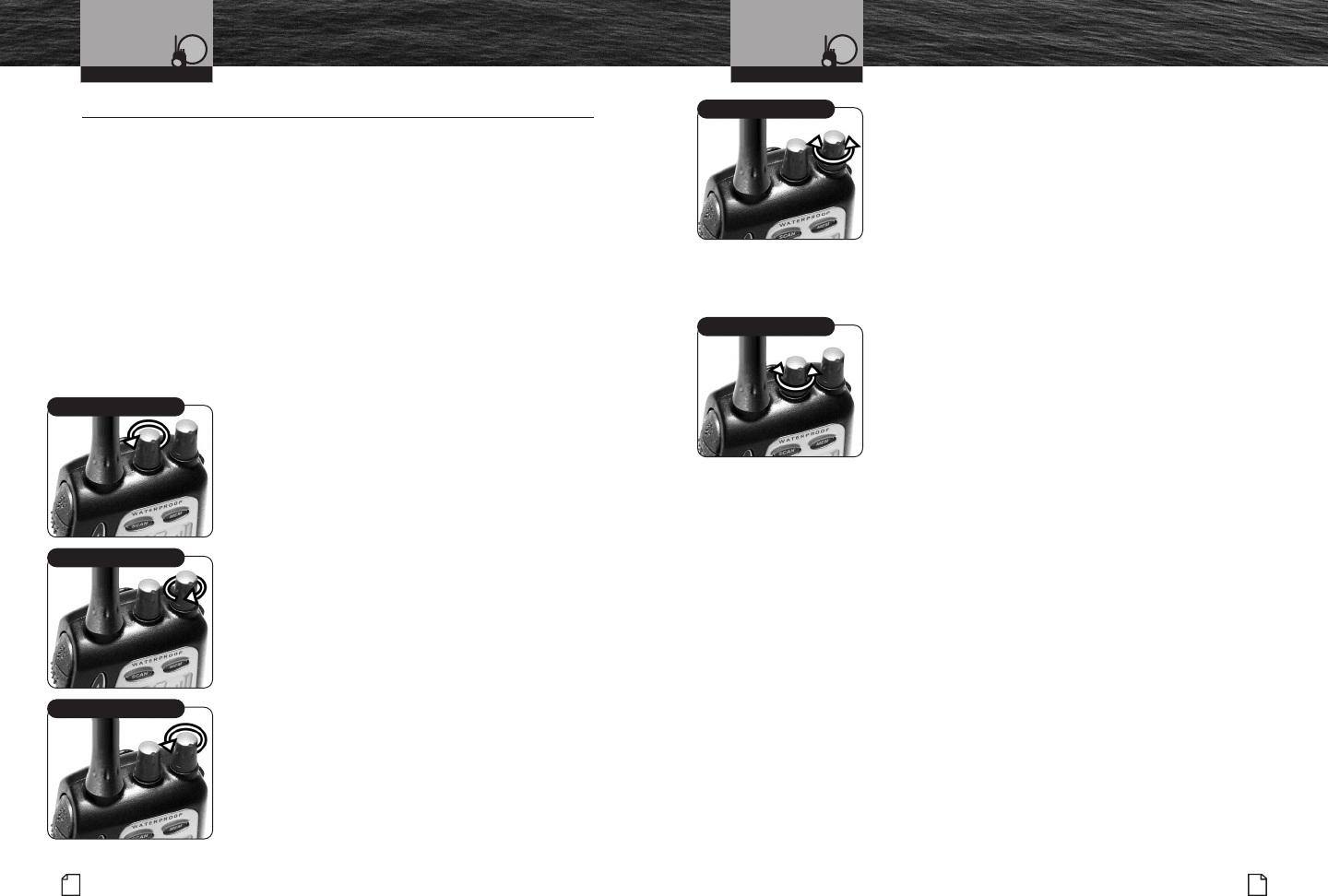
Volume
The On-Off/Volume knob also controls the speaker volume.
The volume adjustment applies only to what you hear from
the speaker and does not affect the volume of your outgoing
messages, which is controlled by the circuitry of your radio.
To Increase The Volume:
1. Turn the On-Off/Volume knob counter-clockwise.
To Decrease The Volume:
1. Turn the On-Off/Volume knob clockwise.
Squelch
Squelch control filters weak signals and radio frequency
noise so that you can more clearly hear the signals you want.
To Squelch Your Radio:
1. With the Squelch knob turned fully counter-clockwise,
turn the On-Off/Volume knob clockwise until you hear
a hissing (noise) sound.
2. Turn the Squelch knob clockwise until the hissing
sound stops. Turning the Squelch further clockwise will
filter weak and medium strength signals until only the
strongest signal can get through at its highest setting.
To receive weaker signals, turn the Squelch
knob counterclockwise.
If the Squelch is set so you can hear a continuous hissing
sound, the Scan and Tri-Watch functions will be blocked.
31
Nothing comes close to a Cobra®
30 English
Getting Started Getting Started
Getting Started •
Refer to the foldout on the front cover of this manual to identify the various
controls and indicators on your radio.
Throughout this manual you will be instructed to press or to press and hold buttons
on the radio or on the microphone/speaker. Press means a momentary press, then
release; press and hold means to hold the button down for three (3) seconds or more.
Whenever you press any button except the Talk button on your radio,a brief tone
(beep) will sound to confirm the button press. With all button presses, the appropriate
icon will appear on the LCD and the backlight will turn On. The backlight will stay
On for five (5) seconds after the button is released.
At times you will hear two (2) other sounds. Two (2) beeps will sound to confirm
your setting changes and three (3) beeps will sound to notify you of an error.
Power On-Off
The On-Off/Volume knob on the top of the radio is held in the Off position by a click stop.
To Turn Your Radio On:
1. Turn the Squelch knob all the way
counter-clockwise (when viewed from above).
2. Turn the On-Off/Volume knob clockwise
until you hear and feel a click.
When the radio is powered On, a brief tone will sound,
the display backlight will turn On, and the display will
show all icons for two (2) seconds. All buttons will be
inoperative during these two (2) seconds.
After two (2) seconds, the radio will return to the settings
in effect when it was last powered Off, the LCD will show
the appropriate icons, and all controls will be operative.
The radio will then be in Standby mode.
When first turned On or after memory loss, the following
defaults will be set:
■ Channel 1A
■ Transmit power high
■ Frequency channel map set to U.S.A.
■ Battery indicator set
■ Tri-Watch memory locations set to Channel 16 and 9.
To Turn Your Radio Off:
1. Turn the On-Off/Volume knob all the way
counter-clockwise until you hear and feel a click.
Operating Your Radio Operating Your Radio
On-Off/Volume Knob
On-Off/Volume Knob
Squelch Knob
On-Off/Volume Knob
Squelch Knob
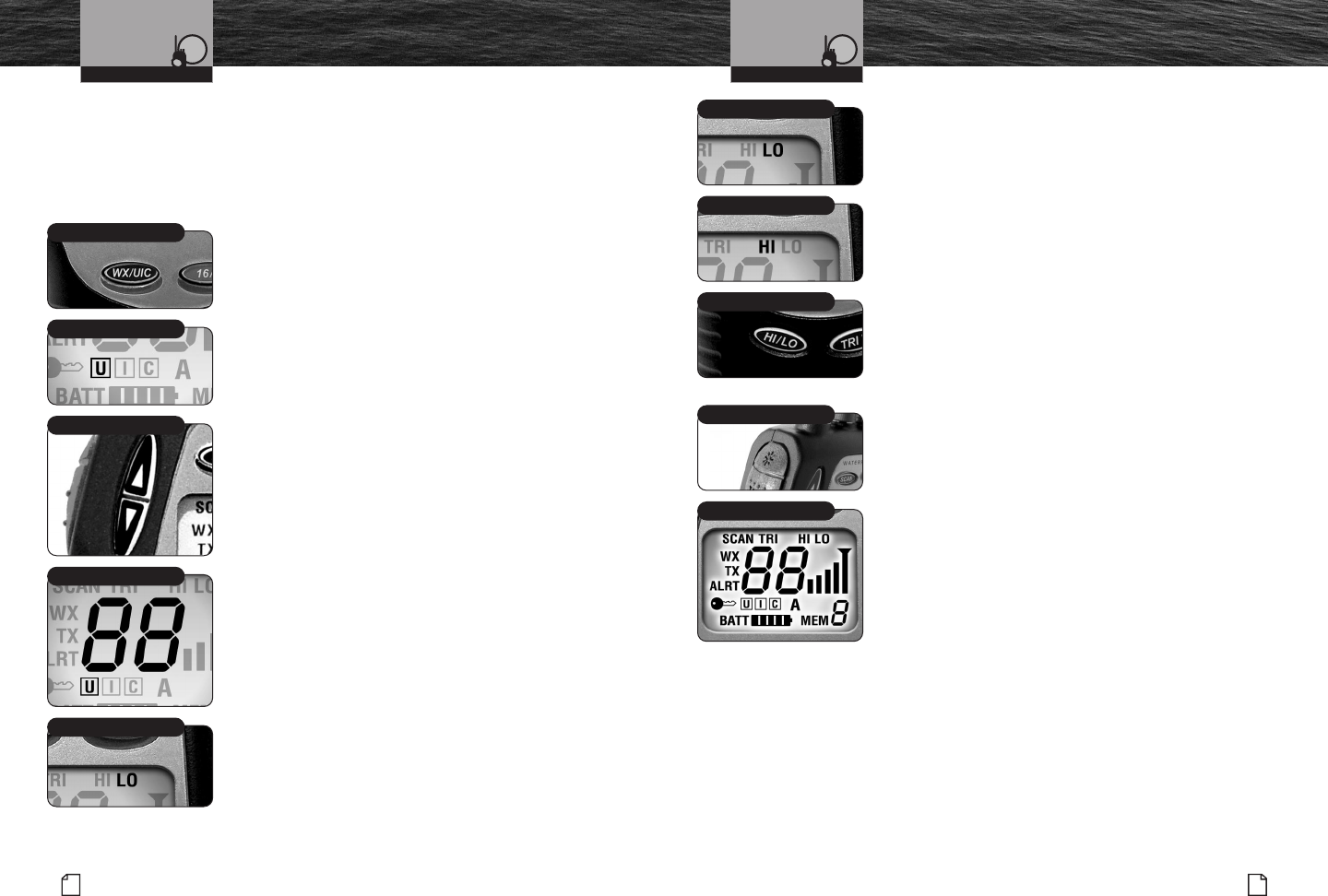
33
Nothing comes close to a Cobra®
32 English
Getting Started Getting Started
U.S.A./International/Canada Channel Maps
Three (3) sets of VHF channel maps have been established for marine use in the
U.S.A., Canada, and the rest of the world (International). Most of the channels
are the same for all three maps, but there are definite differences (see table on
pages 12 through 21). Your radio has all three (3) maps built into it and will
operate correctly in whichever area you choose.
To Set Your Radio For The Area
In Which You Will Be Using It:
1. From Standby mode, press and hold the Weather/UIC
button for two (2) seconds. The radio will shift one
channel map and the Active Channel Map icon on
the LCD will show the change on the LCD.
2. Repeat step 1 to shift to the next channel map(s).
Channels
Your radio will receive and transmit VHF signals
on the channel indicated on the LCD. You can change
the channel at any time using the Channel Up and
Channel Down buttons.
To Change Channels:
1. Press the Channel Up or Channel Down button.
You are on Channel 88, pressing the Channel Up
button will advance to Channel 1. If you are on
Channel 1, pressing the Channel Down button
will advance to Channel 88.
You can hold the Channel Up or Channel Down
button for fast advance.
The beep sound will occur only at the first press
of the button and not during fast advance.
If the new channel selected is restricted to low power,
the radio will automatically switch to Low Power mode
and the Low Power icon will appear on the LCD.
If the radio is in the Key Lock mode, the channel will not
change and the three (3) beep error signal will sound.
Transmit Power Output
Your radio can transmit selectively at one (1) or
five (5) watts of power. Cobra®suggests you maintain
the low power setting for short-range communications,
to conserve battery life, and to avoid overpowering
nearby stations with your signal. Use the high power
setting for long-range communications or when you do
not receive a response to a signal sent at one (1) watt.
To Toggle Between The High And Low Power Modes:
1. Press the High/Low Power button.
The LCD will show which mode is in effect.
Some channels are restricted to use at a maximum
of one (1) watt. Your radio will automatically set
the power to Low Power mode when you select
those channels.
Backlight
The LCD will be illuminated by the backlight as long
as any key is pressed and will remain on for five (5)
seconds after the button is released.
If You Need To Turn On The Backlight
Without Disturbing Any Settings:
1. Press the Backlight/Key Lock button. The
backlight will remain On for five (5) seconds.
If the backlight is On, a press of the Backlight/
Key Lock button will turn it Off.
Operating Your Radio Operating Your Radio
Active Channel Map Icon
Weather/UIC Button
Channel Up/Down
Currently On Channel 88
Low Power Mode
High Power Mode
High/Low Power Button
Backlight/Key Lock Button
Illuminated LCD
Low Power Icon
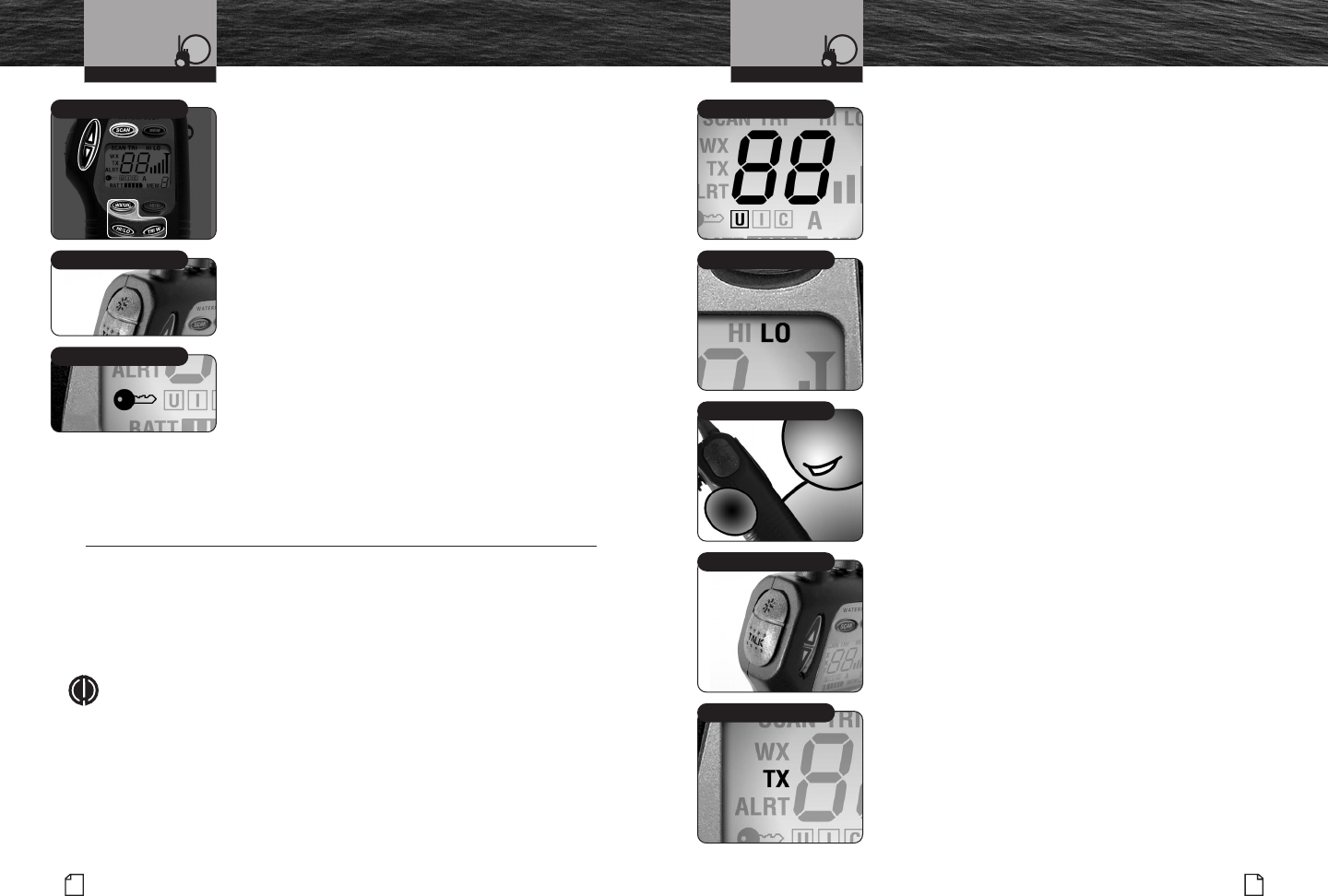
35
Nothing comes close to a Cobra®
34 English
Standby/Receive
and Transmit Standby/Receive
and Transmit
Key Lock
To prevent accidental changes to your settings,
you can lock:
■ Channel Up Button
■ Channel Down Button
■ Scan Button
■ Memory Button
■ Weather/UIC Button
■ 16/9 Button
■ High/Low Button
■ Tri-Watch Button
To Lock Or Unlock The Buttons:
1. Press and hold the Backlight/Key Lock button
for three (3) seconds. The key icon will appear
or disappear in the LCD.
When Key Lock is On, pressing any of the listed buttons
on the front of the radio will result in a three (3) beep
error message. Both the Backlight/Key Lock and the
Talk buttons are active — you can receive or transmit
a message with Key Lock On, but you cannot change
the channel.
Standby/Receive and Transmit •
Standby and Receive
Standby is the usual mode for the radio whenever it is turned On. From this
mode, you can change your settings using the buttons on the front of the radio
and switch to Transmit mode using the Talk button. Signals will be received on
the selected channel(s) and alerts broadcast by the Coast Guard and NOAA will
activate the corresponding routines in your radio.
NOTE
Coast Guard alerts are broadcast on Channel 16 and you
need to have Weather Alert turned On to receive NOAA alerts.
While in Standby mode, you will Receive any messages sent on the channel
to which you are tuned.
Transmit
Transmit mode gives you the ability to interact with safety
services, other vessels, and shore stations. When you use
this capability, be sure to follow the procedures and to
observe the courtesies that govern its use so everyone
benefits. (The tables on pages 12 through 21 will help
you select the proper channels.)
To Transmit A Message:
1. Check to see that your radio is set to a proper
channel for the type of message you plan to send.
2. Toggle to the Low Power setting.
3. With the microphone about two (2) inches (5 cm)
from your mouth press and hold the Talk button
and speak into the microphone. The Transmit icon
will appear on the LCD.
4. Release the Talk button when you are finished
speaking. Your radio can only operate in either the
Transmit or the Receive mode at any given time.
You will not hear the response to your message
unless the Talk button is released.
If the Battery Power icon drops to the blinking
1-segment level on the LCD when the Talk button
is depressed, the radio will NOT transmit and the
Transmit icon will blink.
If the Talk button is held down for five (5) minutes,
the radio will automatically cease transmitting to prevent
unwanted signal generation and battery drain. As soon
as the Talk button is released, it can be pressed again
to resume transmission.
Operating Your Radio Operating Your Radio
2 Inches (5 cm) From Mouth
Low Power Mode
Check Channel Number
Talk Button
Transmit Icon
Lock All Eight (8) Buttons
Key Lock Icon
Backlight/Key Lock Button
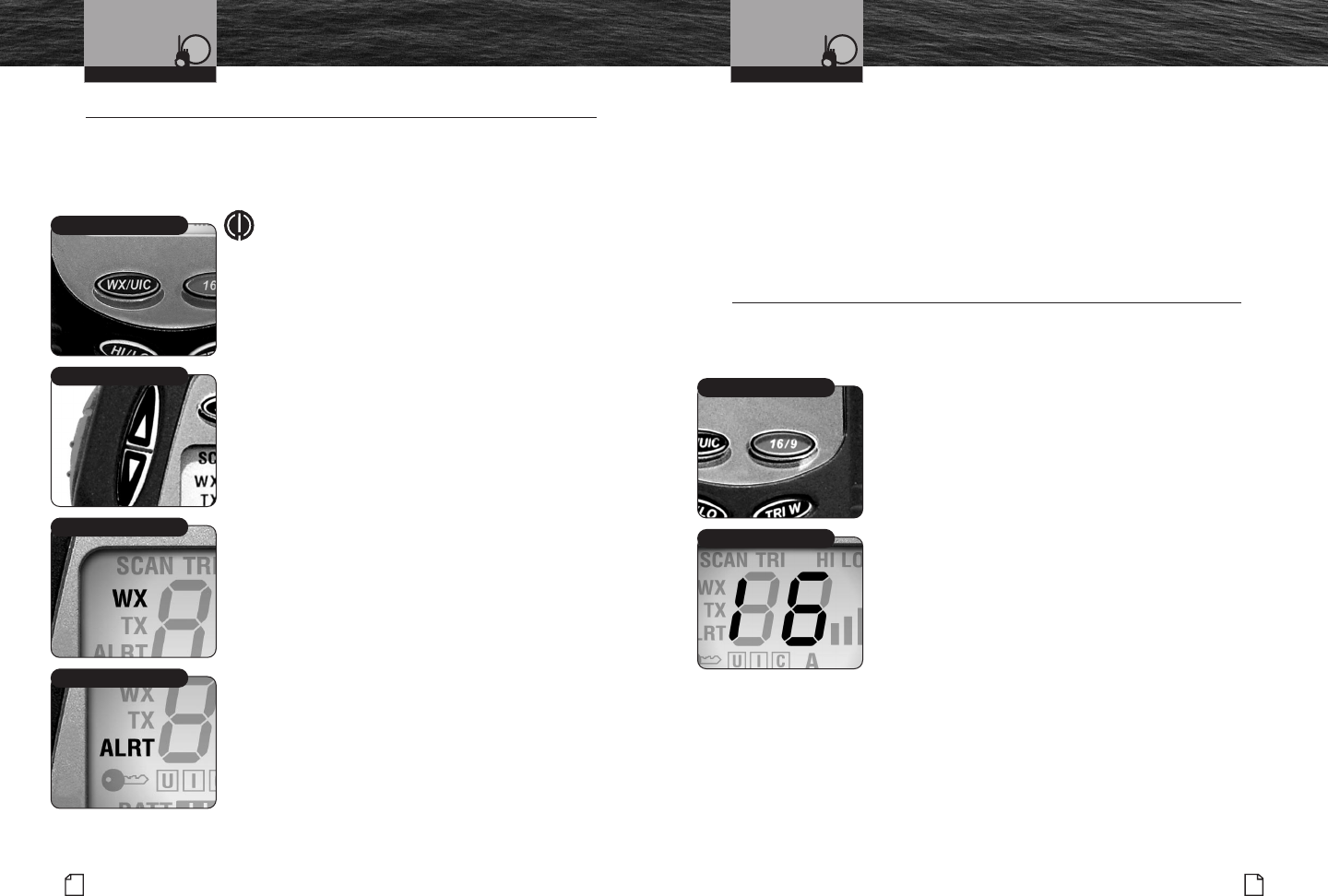
37
Nothing comes close to a Cobra®
36 English
Weather Radio and Alerts Advanced Operation
NOAA All Hazards/Weather Radio and Alerts •
Weather Radio
NOAA broadcasts weather information as described in the NOAA Weather
Channels section on page 22 of this manual. You can tune to these ten (10)
channels at any time (only in the Receive mode).
NOTE
Only one (1) or two (2) of the weather channels will be
operating in any given location. You will need to select
the channel with the strongest signal in your location.
To Listen To The Weather Channels:
1. From Standby mode, press the Weather/UIC button.
The radio will enter the Weather mode and the icon
will show on the LCD.
2. Press the Channel Up or Channel Down button to
change the weather channels — hold the button for
fast advance.
3. To exit the Weather mode and return to Standby
mode, press the Weather/UIC button again.
Weather Alert
NOAA also broadcasts special weather alerts to warn of
severe weather. These are preceded by a special signal
that your radio can detect. However, you must set your
radio to the weather channel that broadcasts a strong
signal in the area where you are, and you must activate the
Weather Alert mode on your radio to benefit from this signal.
To Activate Weather Alert:
1. Enter the Weather mode and select a station with a
strong signal as described above.
2. Press and hold the Weather/UIC button for two (2)
seconds to turn the Weather Alert mode On or Off.
The Alert icon on the LCD will turn On or Off.
3. To exit the Weather mode and return to Standby mode,
press the Weather/UIC button again.
Weather Alert Signal
When NOAA broadcasts a weather alert signal and your radio is in the Weather
Alert mode, you will hear a continuous audible tone and the Alert icon will flash
on the LCD. The alert indicators will sound and flash regardless of what channel
you are operating on as soon as a NOAA alert signal is received.
When You Hear The Alert:
1. Press any key to turn Off the alert indicators.
2. Switch to the weather channel you selected to hear the NOAA emergency broadcast.
Advanced Operation •
Channel 16/9
This function gives you quick access to the calling Channels — 16 and 9 —
from any operational mode.
To Switch To Channel 16 Or 9:
1. Press the Channel 16/9 button to change to Channel 16.
2. Press the Channel 16/9 button again to change to Channel 9.
3. To exit the Channel 16/9 mode and return to whatever
status existed before entering this mode, press the
Channel 16/9 button a third time.
While at Channel 16 or 9in this mode, you can
also press the Channel Up and Channel Down buttons
to change channels. In that event, another press of
the Channel 16/9 button will switch your radio to
Channel 16 and the sequence will start over at step 1.
If you press this button when Key Lock mode is On,
you will get a three (3) beep error message and your
radio will not change mode.
Operating Your Radio Operating Your Radio
Channel 16/9 Button
Channel 16
Channel Up/Down
Weather/UIC Button
Weather Icon
Alert Icon
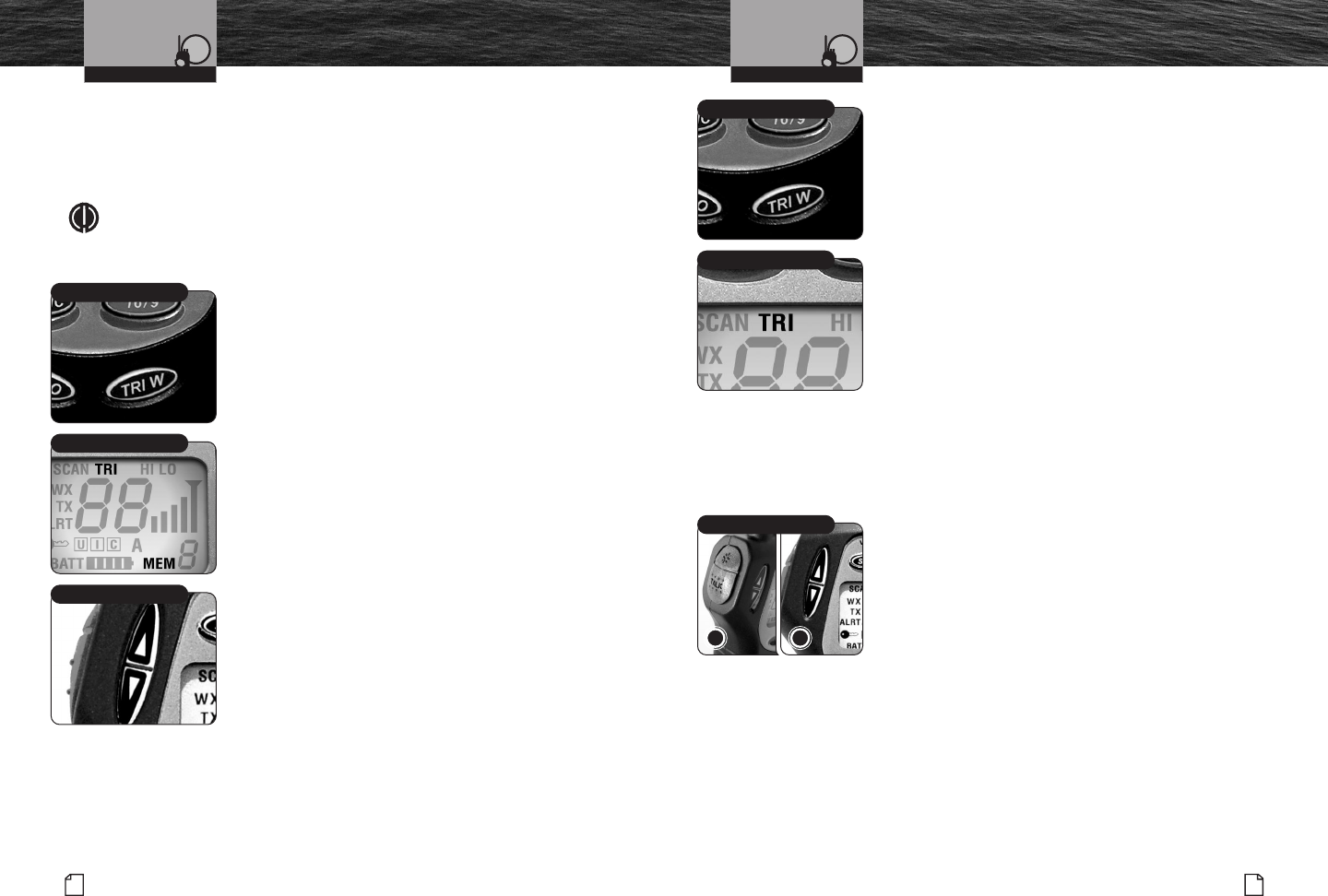
39
Nothing comes close to a Cobra®
Advanced Operation
38 English
Advanced Operation
Tri-Watch
Tri-Watch gives you one-button access to scan the three locations of most
importance to you. Channel 16 will always be one of the scanned locations.
The other two (2) locations will be stored in the radio. They can be edited
and/or recalled for future engagements of Tri-Watch mode.
NOTE
The radio must be Squelched for Tri-Watch to function.
See page 29 for Squelch procedure.
To Program Or Edit The Tri-Watch Locations:
1. Press and hold the Tri-Watch button for three (3)
seconds. The Tri-Watch and Memory icons on
the LCD will be turned On.
2. Press the Channel Up or Channel Down button
to move to the channel you want to enter into
Tri-Watch location one.
3. Press the Tri-Watch button. You will hear a
two (2) beep confirmation signal.
4. Press the Channel Up or Channel Down button
to move to the channel you want to enter into
Tri-Watch location two.
5. Press the Tri-Watch button. You will hear a
two (2) beep confirmation signal and the Memory
icon will disappear from the LCD. The radio will
immediately engage Tri-Watch (see page 37
for further details).
To Enter Tri-Watch Mode:
1. From Standby mode, press the Tri-Watch button.
The Tri-Watch icon will appear on the LCD and the radio
will scan among Channel 16, Tri-Watch location one, and
Tri-Watch location two. A signal on any one of the three (3)
locations will stop the scan for ten (10) seconds to allow
you to listen to the traffic on that location.
To Exit Tri-Watch Mode:
1. Press the Tri-Watch button.
The icon will disappear from the LCD and the
radio will return to Standby mode status.
During An Incoming Transmission,
You Can Choose From The Following:
a. Press the Talk button to remain on that
Tri-Watch location and return to Standby mode.
b. Press the Channel Up or Channel Down button
to resume scanning Tri-Watch locations.
If you do not press any buttons within ten (10)
seconds, your radio will automatically resume
scanning Tri-Watch locations.
During Scanning (While Not Receiving A Transmission),
You Can Choose From The Following:
a. Press the Talk button to communicate on the
last Tri-Watch location scanned and return to
Standby mode.
b. Press the Channel Up or Channel Down button
to change scan direction.
Operating Your Radio Operating Your Radio
Channel Up/Down
Tri-Watch Button
Tri-Watch Button
Tri-Watch and Memory Icons
Tri-Watch Icon
a
Talk or Channel Up/Down
b
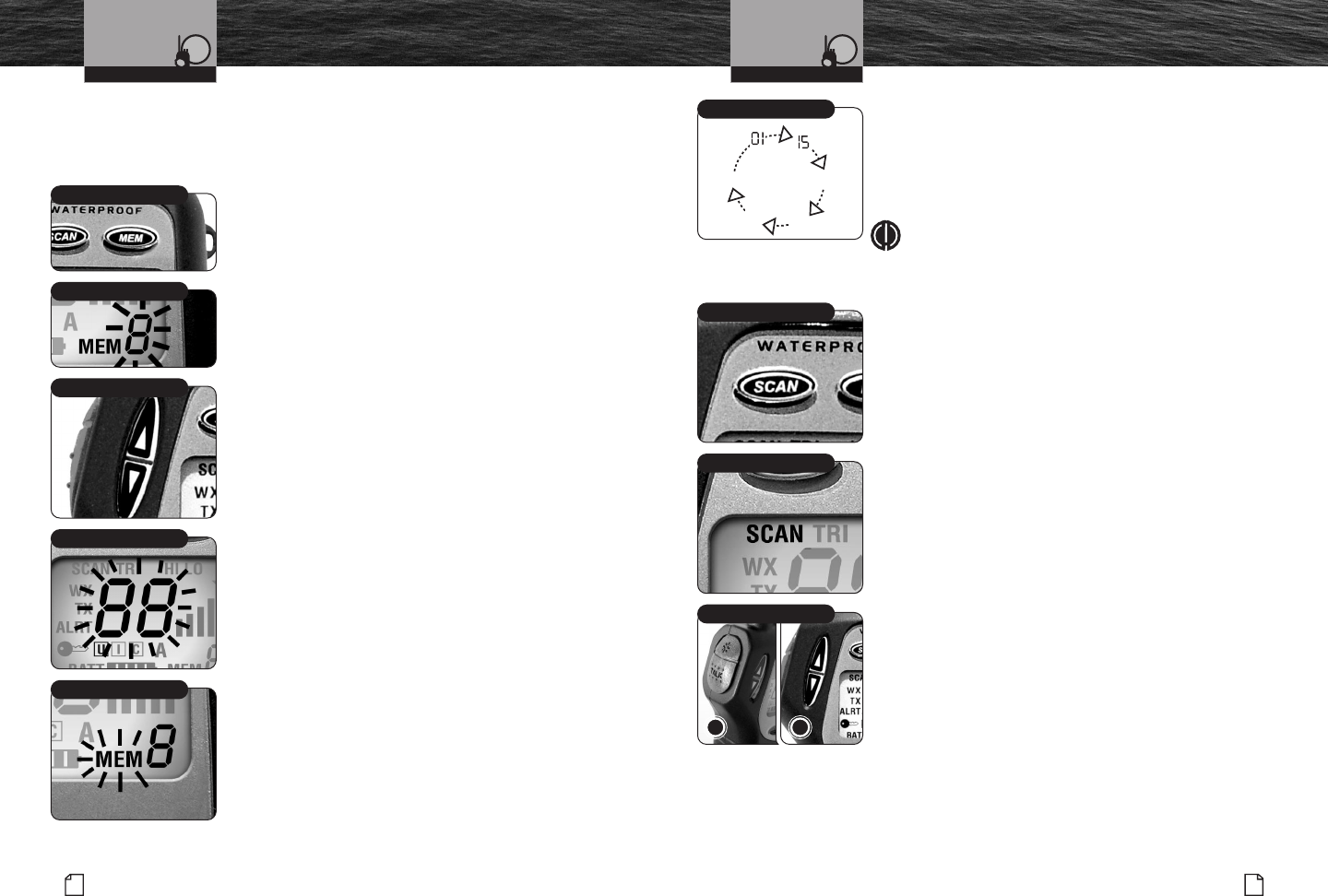
41
Nothing comes close to a Cobra®
Advanced Operation
40 English
Advanced Operation
Memory Locations
Your radio has ten (10) memory locations for storing your most frequently used
channels. These memory locations can be selected individually or can be scanned
(see Memory Location Scan, page 40).
To Program Memory Locations:
1. Press and hold the Memory button for three (3)
seconds. The memory location number will start
flashing and Memory icon will be turned On.
2. Use the Channel Up or Channel Down button
to change to the memory location (0 to 9) you
want to program.
3. Press the Memory button to select the memory
location. The Memory Channel Number will stop
flashing and the channel number will start flashing.
4. Use the Channel Up or Channel Down buttons to
change to the channel you want to store in the selected
memory location.
5. Press the Memory button to program that channel
into the selected memory location. The Memory icon
will begin flashing again.
Repeat steps 2 to 5 to program as many additional
memories as you want, up to a total of ten (10).
6. Press and hold the Memory button for three (3)
seconds. This will return the radio to Standby mode.
To Recall A Stored Memory Location:
1. Press the Memory button. The Memory icon
will be turned On.
2. Press the Channel Up or Channel Down button to
select the memory location (0 to 9). If a memory
location has been programmed, its associated
channel will be shown on the LCD.
Your radio is now in Standby mode on the selected
memory location.
To Exit Memory Location Mode:
1. Press the Memory button to return the radio to
Standby mode on the last channel shown on the
LCD before entering Memory Location mode.
Channel Scan
During scan, the radio will rapidly switch from channel
to channel through all the channels. Whenever any activity
is detected, the radio will stop the scan for ten (10) seconds
to allow you to listen briefly on that channel. It will then
continue to scan unless you switch out of the Scan mode.
NOTE
The radio must be Squelched for the Channel Scan
to function. See page 29 for Squelch procedure.
To Enter Channel Scan:
1. From Standby mode, press the Scan button.
The radio will immediately begin to scan the entire
Channel Map selected in the Active Channel Map.
The Scan icon will show on the LCD.
To Exit Channel Scan:
1. From Scan mode, press the Scan button.
This will return the radio to Standby mode
on the last scanned channel.
During An Incoming Transmission,
You Can Choose From The Following:
a. Press the Talk button to remain on that channel
and end scanning. This will return the radio to
Standby mode.
b. Press the Channel Up or Channel Down button
to resume scanning channels.
If you do not press any buttons within ten (10) seconds,
your radio will automatically resume scanning channels.
Scan Button
88 30
60
75
Scanning
Memory Button
Scan Icon
Memory Location Number
Channel Number
Memory Icon
Channel Up/Down
Operating Your Radio Operating Your Radio
a
Talk or Channel Up/Down
b
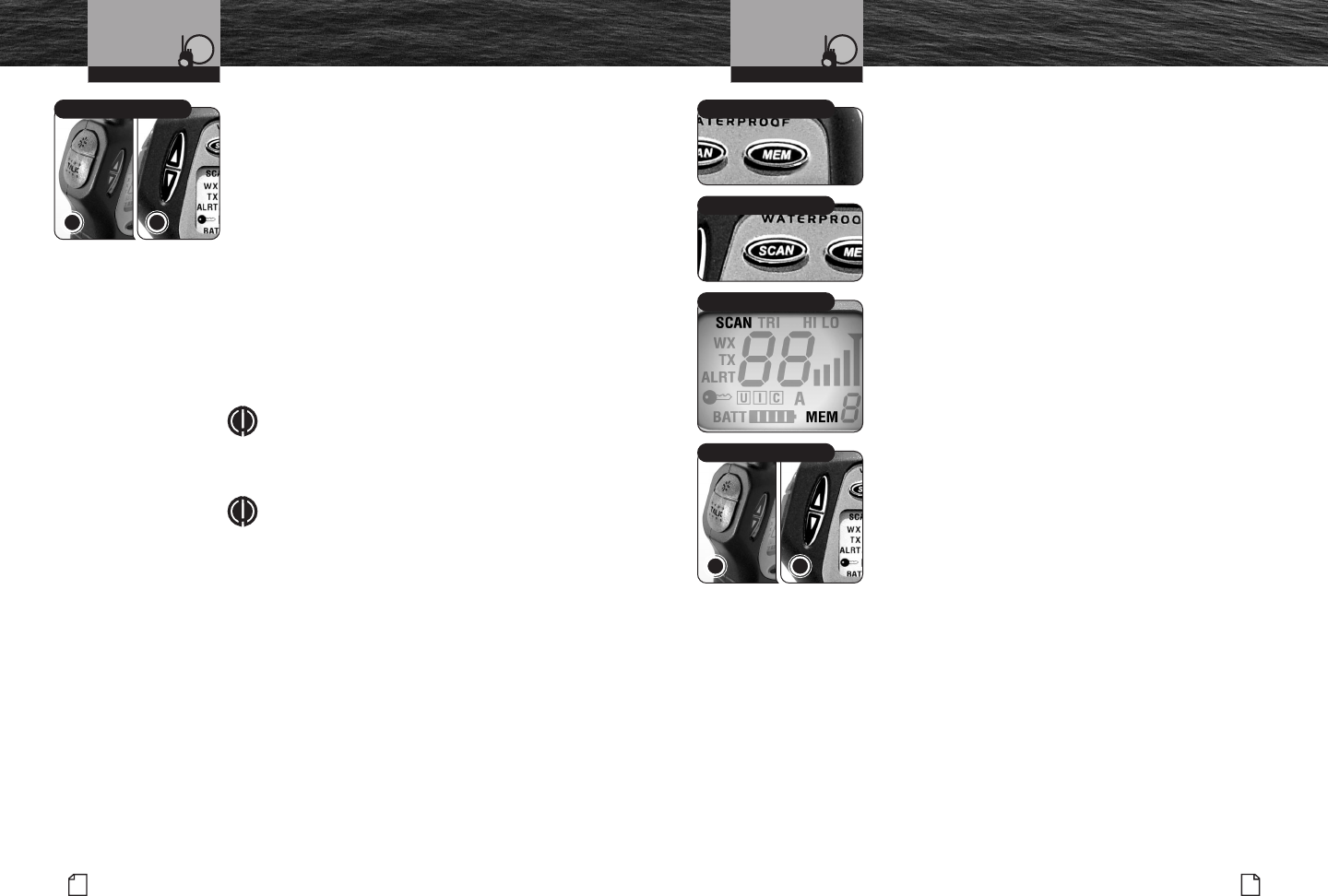
43
Nothing comes close to a Cobra®
Advanced Operation
42 English
Advanced Operation
During Scanning (While Not Receiving
A Transmission), You Can Choose From
The Following:
a. Press the Talk button to communicate on
the last memory location scanned and return
to Standby mode.
b. Press the Channel Up or Channel Down
button to change scan direction.
Memory Location Scan
During memory location scan, the radio will rapidly
switch from memory location to memory location.
Whenever any activity is detected, the radio will stop
the scan for ten (10) seconds to allow you to listen
briefly on that memory location. It will then continue
to scan unless you switch out of the Scan mode.
NOTE
The radio must be Squelched for the Memory
Location Scan to function. See page 29 for
Squelch procedure.
NOTE
If there are one or fewer memory locations
programmed in the radio, the Memory Location
Scan option will not be available. See “To Program
Memory Locations” to program at least two (2)
memory locations.
To Enter Memory Location Scan:
1. From Standby mode, press the Memory button.
2. Press the Scan button.
The radio will immediately begin to scan the channels
you programmed into the memory. The Scan and
Memory icons will show on the LCD.
To Exit Memory Location Scan:
1. From Memory Location Scan mode, press the Scan
button. This will return the radio to Standby mode
on the last scanned memory location.
During An Incoming Transmission,
You Can Choose From The Following:
a. Press the Talk button to remain on that memory
location and end scanning. This will return the
radio to Standby mode.
b. Press the Channel Up or Channel Down button
to resume scanning memory locations.
If you do not press any buttons within ten (10)
seconds, your radio will automatically resume
scanning memory locations.
During Scanning (While Not Receiving A Transmission),
You Can Choose From The Following:
a. Press the Talk button to communicate on the last
memory location scanned and return to Standby mode.
b. Press the Channel Up or Channel Down button to
change scan direction.
Memory and Scan Icons
Memory Button
Scan Button
Operating Your Radio Operating Your Radio
a
Talk or Channel Up/Down
b
a
Talk or Channel Up/Down
b
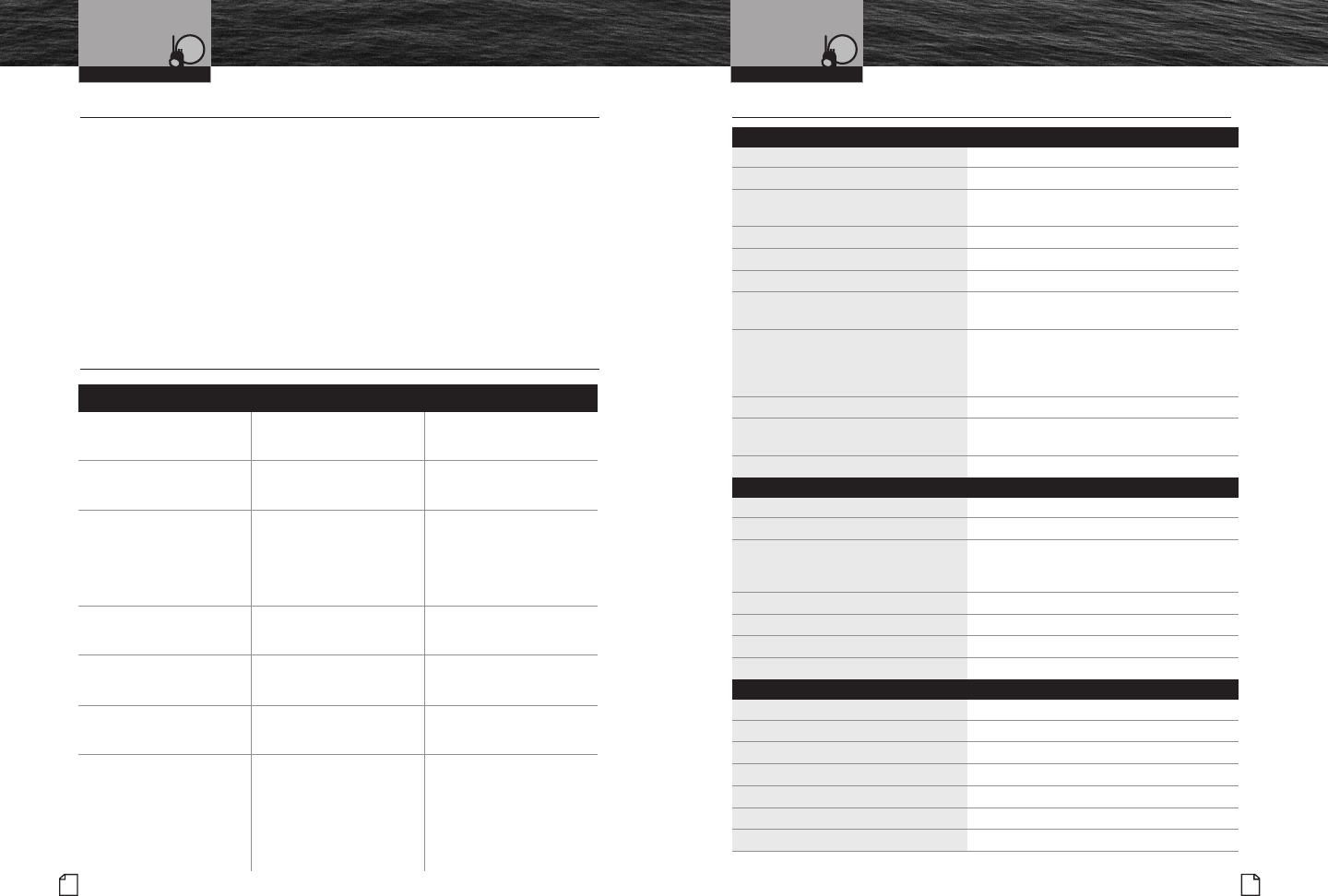
No display on LCD when
radio is turned On Batteries are exhausted Recharge or replace
batteries
NiMH batteries run
down quickly Batteries are at the
end of their life Replace with new
batteries
Will transmit at
one (1) watt, but not
at five (5) watts
Batteries are low
Selected channel is
limited to one (1) watt
Recharge or
replace batteries
Switch to
another channel
Will not transmit Selected channel is
limited to receive only Switch to
another channel
No sound from speaker Volume level is too low or
Squelch level is too deep Re-adjust Volume
and Squelch
No response to
button press Key Lock is On Press Backlight/
Key Lock button
No answer to calls Out of range of
other station
Signal is blocked
by terrain
Switch to five (5)
watts or move closer
Move until you have
a “line-of-sight” to
the other station
Problem Possible Cause(s) Solution(s)
45
Nothing comes close to a Cobra®
Specifications
44 English
Maintenance and
Troubleshooting
Specifications •
General
Frequency Range: TX 156.025 to 157.425 MHz
Frequency Range: RX 156.050 to 163.275 MHz
Number of Channels All U.S., Canadian, and International
10 NOAA Weather Channels
Channel Spacing 25 kHz
Modulation 16KOF3E
Input Voltage 7.2 VDC
Battery Life: 8 Hours @ 5 Watts, 10 hours @ 1 Watt
5% TX, 5% RX, 95% Stand-by
Current Drain:
Stand-by 20 mA
Receive 200mA
Transmit 1.8A @ High power 0.7A @ Low
Temperature Range -20˚C to 60˚C
Radio Dimensions 5.5" x 2.2" x 1.4"
(14 cm x 5.6 cm x 3.6 cm)
Radio Weight (Lbs) 1.1 lbs
Receiver
Frequency Range 156.050 to 163.275 MHz
Receiver Type
Sensitivity:
20 dB Quieting 0.35 uV
12 dB Sinad 0.30 uV
Adjacent Channel Selectivity -60dB
Intermodulation and Rejection -60dB
Spurious and Image Rejection -60dB
AF Output 4 Watts @ 8 Ohms
Transmitter
Frequency Range: TX 156.025 to 157.425 MHz
RF Output Power 1 and 5 Watts
Spurious Emissions -60 dB High -55 dB Low
Microphone Type Condenser
Microphone Impedance
Frequency Stability +/-5 ppm
FM Hum and Noise -45dB
Operating Your Radio Operating Your Radio
Maintenance •
Very little maintenance is required to keep your CobraMarine™VHF radio in good
operating condition.
■ Keep the radio and charger clean by wiping with a soft cloth and mild detergent.
Do not use solvents or harsh or abrasive cleaners, which could damage the case
or scratch the LCD screen.
■ If the radio is exposed to salt water, wipe with a soft, moist cloth at least once a day
to prevent build-up of salt deposits, which could interfere with button operation.
■ If the radio will be stored for a long period, such as over the winter,
remove the batteries from the battery tray and store them in a separate package.
This is especially so if you are using alkaline batteries.
Troubleshooting •
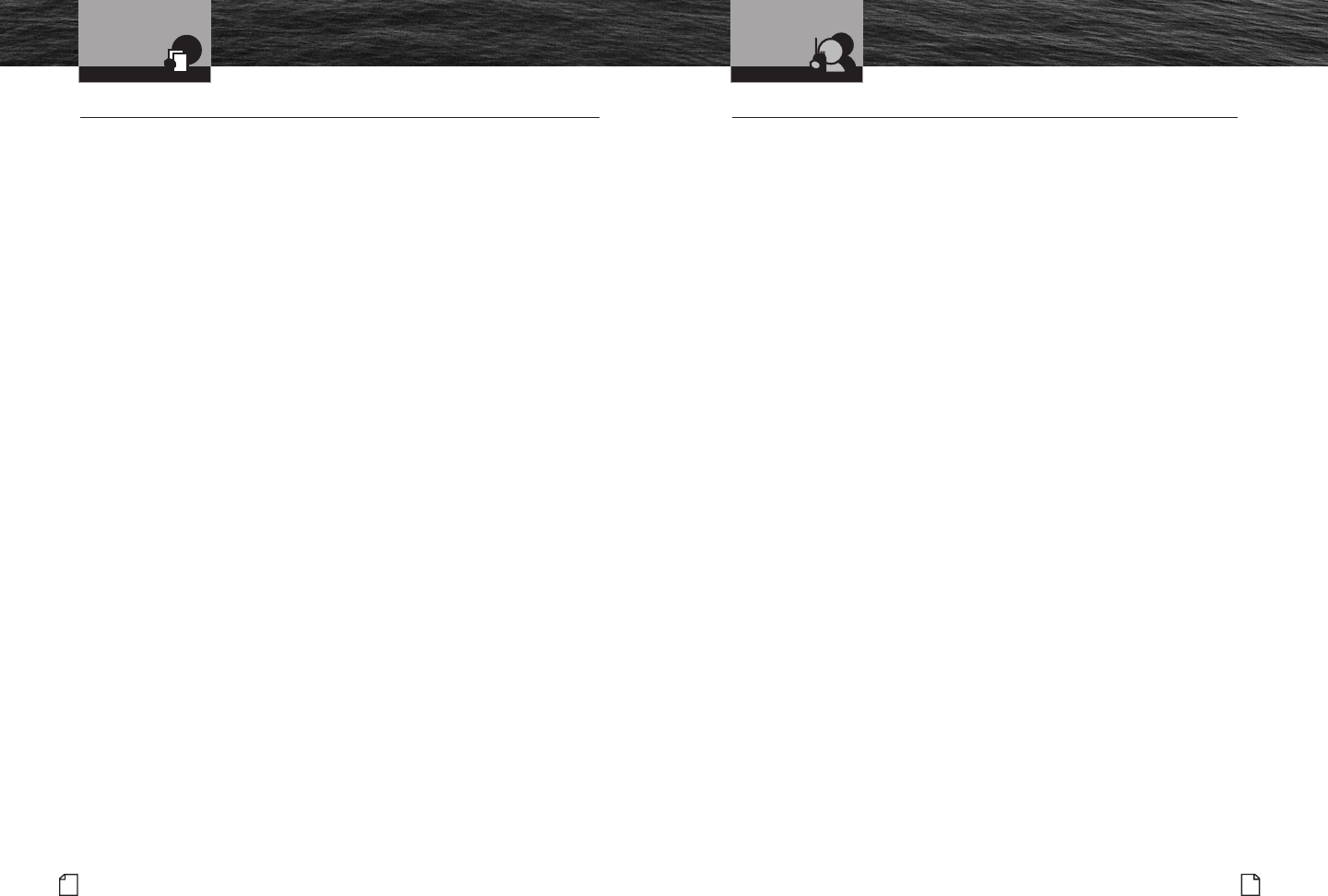
47
Nothing comes close to a Cobra®
Product Service
46 English
Warranty
Product Service •
If you have any questions about operation or installing
your new CobraMarine™VHF product, or if you are
missing parts…
Please call Cobra®first! DO NOT RETURN THIS PRODUCT TO THE STORE!
See customer assistance on page A1.
If your product should require factory service, please call Cobra®first before
sending your radio. This will ensure the fastest turn-around time on your repair.
You may be asked to send your radio to the Cobra®factory. It will be necessary
to furnish the following to have the product serviced and returned:
1. For Warranty Repair include some form of proof-of-purchase, such as
a mechanical reproduction or carbon of a sales receipt. If you send the
original receipt, it cannot be returned;
2. Send the entire product;
3. Enclose a description of what is happening with the radio. Include a typed
or clearly printed name and address of where the radio is to be returned;
4. Pack radio securely to prevent damage in transit. If possible, use the
original packing material;
5. Ship prepaid and insured by way of a traceable carrier such as United
Parcel Service (UPS) or Priority Mail to avoid loss in transit to: Cobra®
Factory Service, Cobra®Electronics Corporation, 6500 West Cortland
Street, Chicago, Illinois 60707 USA;
6. If the radio is in warranty, upon receipt of your radio it will either
be repaired or exchanged depending on the model. Please allow
approximately 3 – 4 weeks before contacting Cobra®for status.
If the radio is out of warranty, a letter will automatically be sent
informing you of the repair charge or replacement charge.
If you have any questions, please call 773-889-3087 for assistance.
Limited 3-Year Warranty •
For Products Purchased In the U.S.A.
Cobra®Electronics Corporation warrants that its CobraMarine™VHF radio, and the
component parts thereof, will be free of defects in workmanship and materials
for a period of three (3) years from the date of first consumer purchase. This warranty
may be enforced by the first consumer purchaser, provided that the product is
utilized within the U.S.A.
Cobra®will, without charge, repair or replace, at its option, defective radios,
products or component parts upon delivery to the Cobra®Factory Service
department, accompanied by proof of the date of first consumer purchase,
such as a duplicated copy of a sales receipt.
You must pay any initial shipping charges required to ship the product for warranty
service, but the return charges will be at Cobra®’s expense, if the product is repaired
or replaced under warranty. This warranty gives you specific legal rights, and you
may also have other rights which may vary from state to state.
Exclusions: This limited warranty does not apply:
1. To any product damaged by accident;
2. In the event of misuse or abuse of the product or as a result
of unauthorized alterations or repairs;
3. If the serial number has been altered, defaced, or removed;
4. If the owner of the product resides outside the U.S.A.
All implied warranties, including warranties of merchantability and fitness for a
particular purpose are limited in duration to the length of this warranty. Cobra®
shall not be liable for any incidental, consequential or other damages; including,
without limitation, damages resulting from loss of use or cost of installation.
Some states do not allow limitations on how long an implied warranty lasts and/or
do not allow the exclusion or limitation of incidental or consequential damages,
so the above limitations may not apply to you.
For Products Purchased Outside the U.S.A.
Please contact your local dealer for warranty information.
Warranty Customer Service
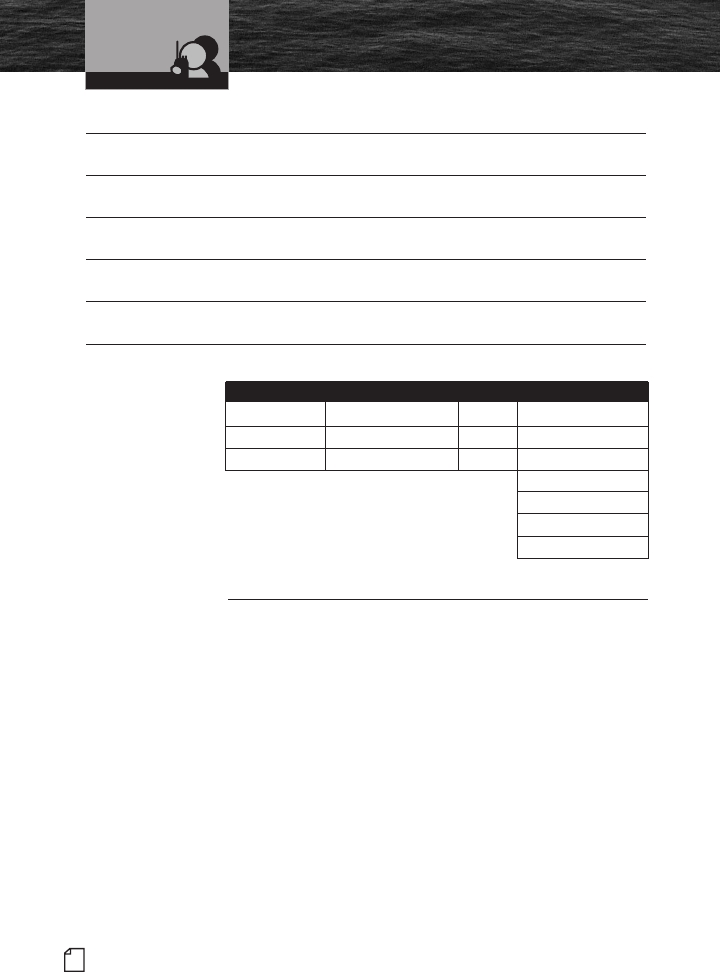
48 English
Optional Accessories
and Order Form
Optional Accessories •
You can find quality Cobra®products and accessories at
your local Cobra®dealer, or in the U.S.A., you can order
directly from Cobra®
.
Ordering From U.S.A.
Call 773-889-3087 for pricing or visit www.cobra.com.
For credit card orders, complete and return this order
form to fax number 773-622-2269. Or call 773-889-3087
(Press 1 from the main menu) 8:00 a.m. to 6:00 p.m. CT,
Monday through Friday.
Make check or money order payable to:
Cobra®Electronics, Attn: Accessories Dept.
6500 West Cortland Street, Chicago, IL 60707 USA
To order online, please visit our website: www.cobra.com
The Cobra®
line of quality
products includes:
CB Radios
microTALK®Radios
Radar/Laser Detectors
Safety Alert®Traffic
Warning Systems
Accessories
GPS (Global
Positioning System)
HighGear™Accessories
VHF Marine Radios
Power Inverters
Name
Address (No P.O. Boxes)
City State/Province Zip Country
Telephone
Credit Card Number Type: ❒Visa ❒Mastercard ❒Discover Exp. Date
Customer Signature
Item # U.S. Cost Each Qty Amount
U.S. Subtotal
(Tax if Applicable)
Shipping/Handling
Total
Amount Shipping/Handling*
$10.00 or less . . . . . $3.00
$10.01-$25.00 . . . . . $5.50
$25.01-$50.00 . . . . . $7.50
$50.01-$90.00 . . . . $10.50
$90.01-$130.00 . . . $13.50
$130.01-$200.00 . . $16.50
$200.01 plus . . . . 10% off
purchase
*For AK, HI and PR add
additional $26.95 for FedEx
Next Day or $10.95 for
FedEx 2nd Day. Excludes
weekend and holiday
shipments.
Please allow 2-3 weeks
for delivery in the U.S.
Prices subject to change
without notice.
Tax Table
Wisconsin add 5%
Indiana, Ohio, Michigan add 6%
California add 7.25%
Illinois add 8.75%
Customer Service